Herculaneum
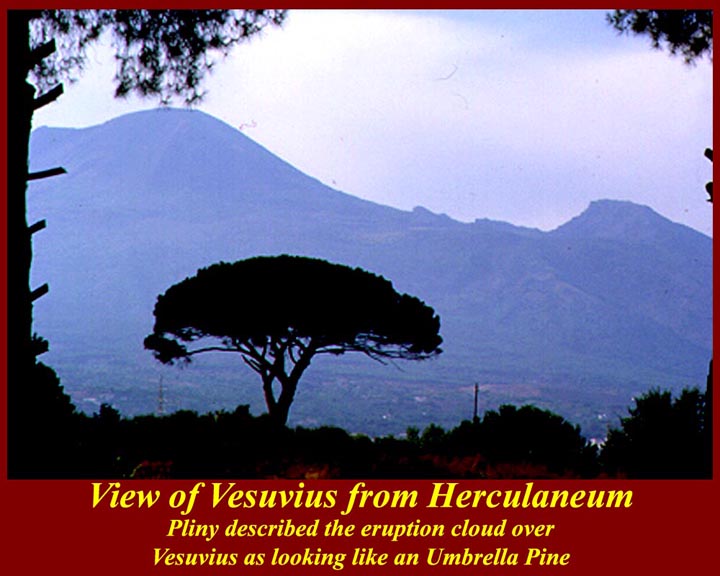 http://www.mmdtkw.org/ALRIVes0401VesuvUmbrellaPine.jpg
http://www.mmdtkw.org/ALRIVes0401VesuvUmbrellaPine.jpg
Pliny, the Younger, described the cloud rising from Vesuvius
that day in 79 AD as looking like a pine tree. Although he
didn't state the species name the description is clearly of the
pine type in the picture which is known as pinus maritimus or pinus pinea and commonly
called in English the "Umbrella Pine". This one is in modern Ercolano
(Herculaneum) at the foot of Vesuvius. Pliny's description of the
eruptive cloud: "...its general appearance can best be
expressed as being like a pine, for it rose to a great height on
a sort of trunk and then split off into branches, I imagine
because it was thrust upwards by the first blast and then left
unsupported as the pressure subsided, or else it was borne down
by its own weight so that it spread out and gradually
dispersed...."
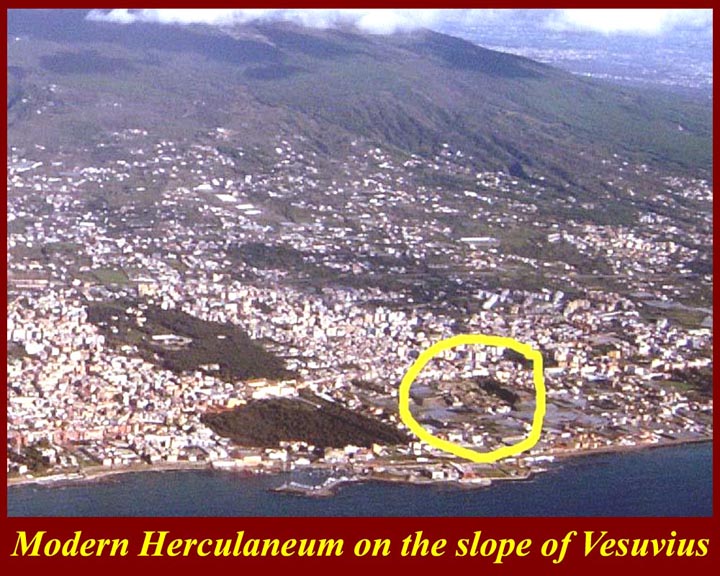
http://www.mmdtkw.org/ALRIVes0402AreaAerial.jpg
The picture shows modern Ercolano
on the slope of Vesuvius. The excavations are
circled. At the time of the 79 AD eruption the shore side
of the excavations was the beach. After the eruption the
accumulation of debris and volcanic fallout move the shoreline
half a kilometer into the sea. The two darker areas (where
there is little building) are lava flows from the 1760-61
effusive-explosive eruptions. Clearly, the one to the left
cut the main road. Volcanologists today worry that this
same road is still the main evacuation route for persons in the
"red zone", which they believe will be hit by either effusive or
pyroclastic flows in any future eruption. Remember,
the top of the magma
chamber is now thought
to be 1.5 kilometers below the surface, and it is thought
to contain over 300 cubic kilometers of magma. There
are more than 1.5 million people in the "red zone", and
only a few tens of thousands have taken advantage of an Italian
government buy-out designed to reduce the population of the
zone.
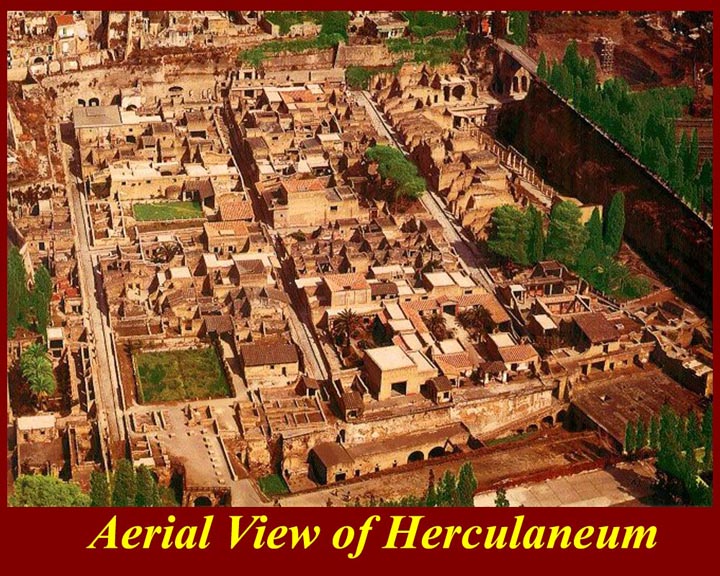
http://www.mmdtkw.org/ALRIVes0403Aerial.jpg
An aerial view of the excavated area -- additional areas have
been reached by tunneling. The excavated area is very
small compared to Pompeii (only a few square blocks = insulae),
but, still, think of the arduous task of removing all of that
heat-consolidated rock. The debris that buried Pompeii had
already cooled to the point that the particles would not fuse
together (but were still hot enough to kill everyone
instantly.) Herculaneum, at four kilometers from the
vent, was only one third the distance that Pompeii was, so the debris was
correspondingly hotter -- hot enough to melt itself together and
to fool generations of experts who thought it had arrived as a
relatively slow-moving mud-flow. For the
first twelve hours of the eruption, only a fine dusting of ash
fell on the town. Then
the Plinian eruptive column -- the trunk of that "pine tree"
collapsed, and the first pyroclastic surge/flow pair rolled over
Herculaneum about four minutes later. If you happened to
be looking up hill -- and many people undoubtedly were --
you could see it coming but had little chance of escape.
It's probable that this is when those who had gone down to the
shoreline hoping to escape by sea fled into the arched
boat sheds where they were found more than 1900 years
later.
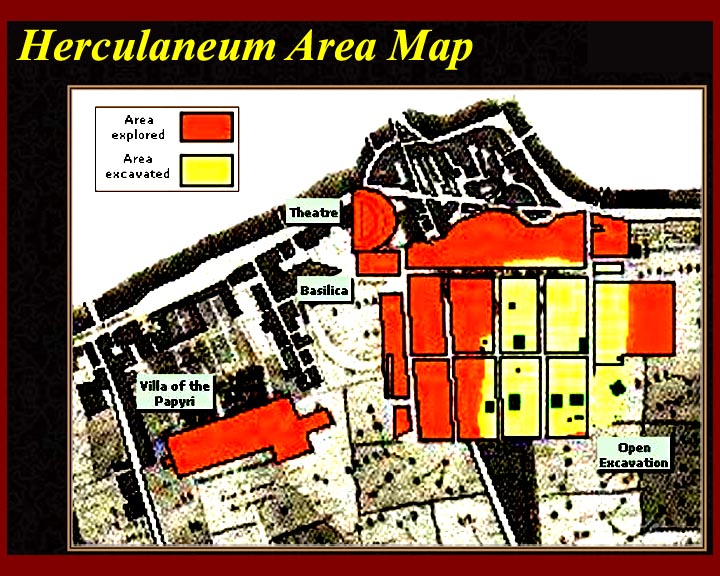
http://www.mmdtkw.org/ALRIVes0404ExcavMap.jpg
The map shows the excavated are in yellow and areas reached by
tunneling in red. It is assumed that even larger areas
have never been excavated: unlike Pompeii, Herculaneum was
resettled soon after the eruption and has been continuously
occupied since. Initial exploration of the ruins was by
tunneling -- by happenstance in the area of the theater and the
Villa of the Papyri. Excavation (meaning removal of large
areas of volcanic overlay) began in earnest in the 19th century,
and only very slowly has urban land been acquired to continue
digging. The current policy, as in Pompeii, is to
consolidate and preserve rather than to dig up additional
areas. The most controversial aspect of this policy
concerns the Villa of the Papyri where document specialists want
to look for the supposed (actually, just wished-for) Latin
library.
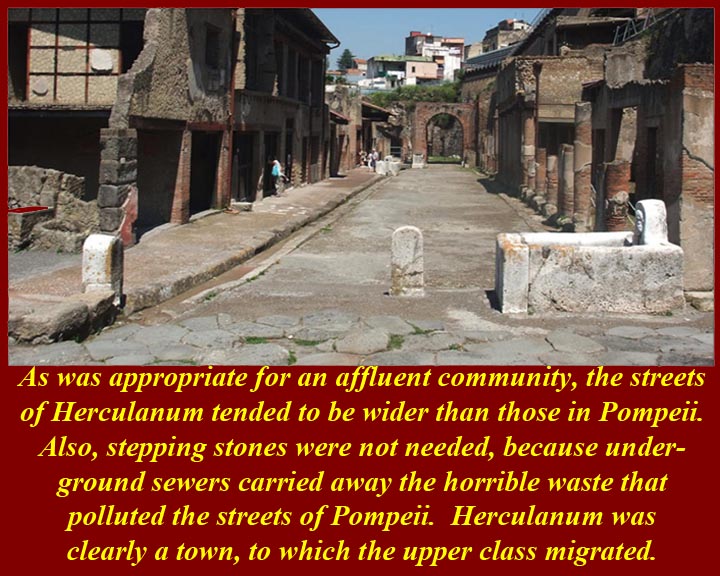
http://www.mmdtkw.org/ALRIVes0404wWideStreetHerculanum.jpg
Streets in Herculanum were wider than those in Pompeii, and
steping stones to cross streets were not necessary --
underground sewers kept the streets relatively clean of the kind
of effluent that flowed in Pompeii's gutters.
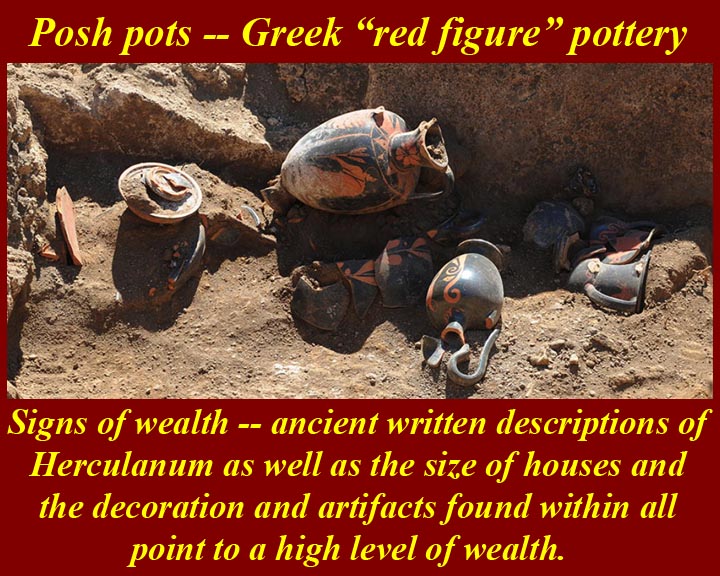
http://www.mmdtkw.org/ALRIVes0404xExpensivePotsHerculanum.jpg
Luxury pottery found in Herculanum vs. tons of locally made
wares in Pompeii.
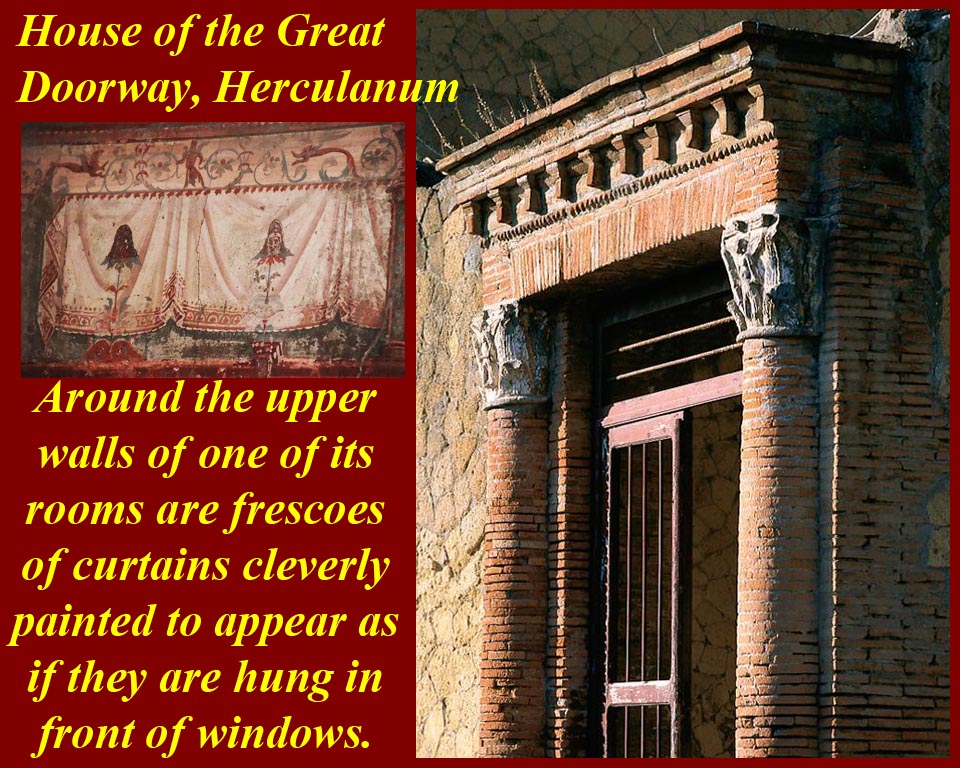
http://www.mmdtkw.org/ALRIVes0404yGreatDoorwayHouse.jpg
Extravagant architectural details and high end fresco work was
common.
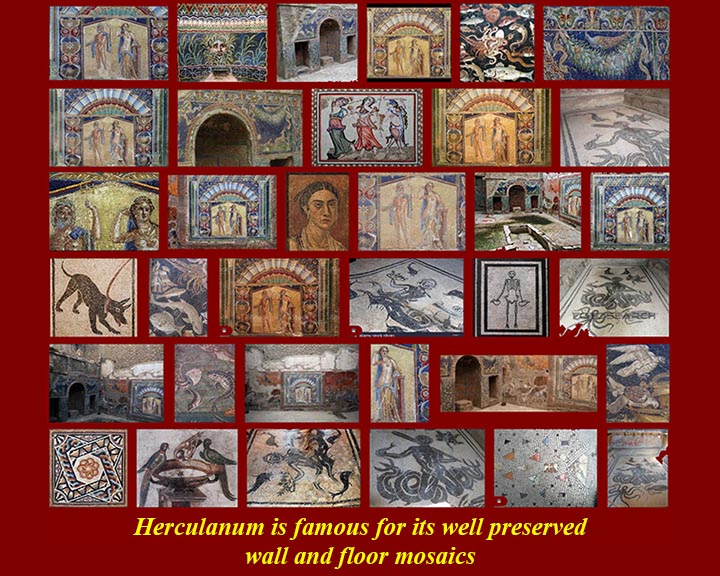
http://www.mmdtkw.org/ALRIVes0404zHerculanumMosaics.jpg
Many mosaics -- much more expensive to instsll and maintain
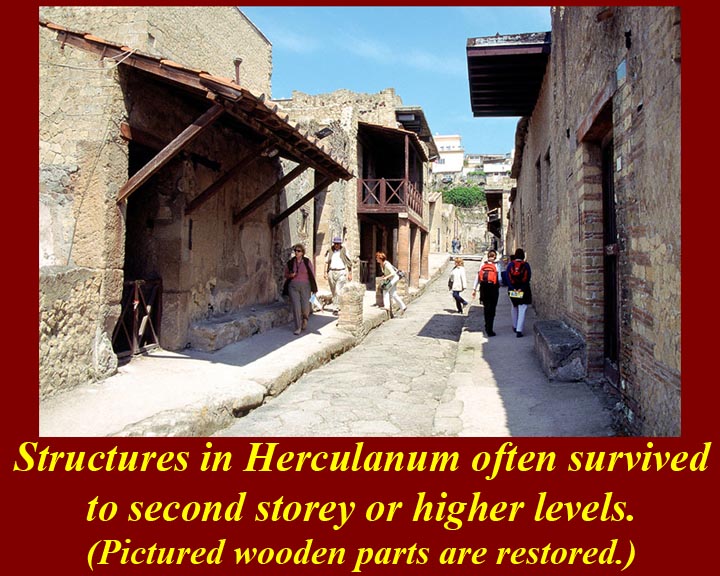
http://www.mmdtkw.org/ALRIVes0404zzUpperFloorsSurvived.jpg
Because of local topography and the characteristics of the
pyroclastic surges/flows that burried Herculanum, there was a
greater chance of survival of upper levels of structures.
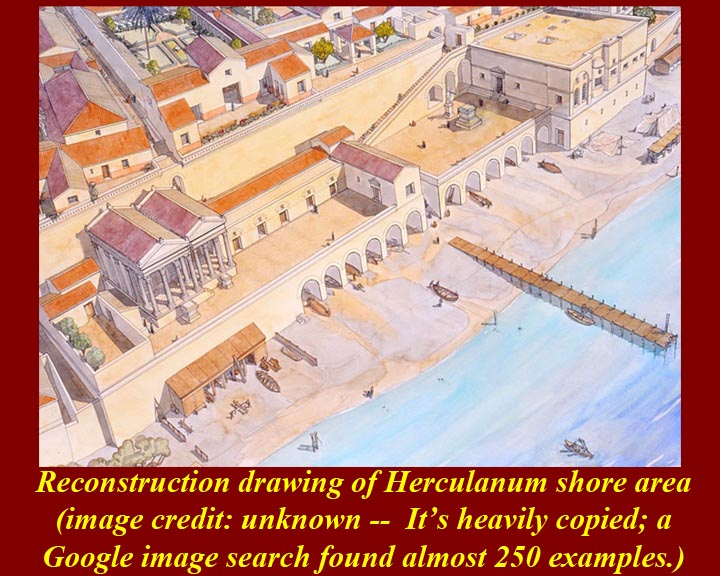
http://www.mmdtkw.org/ALRIVes0405oaHerculanumShoreDrawing.jpg
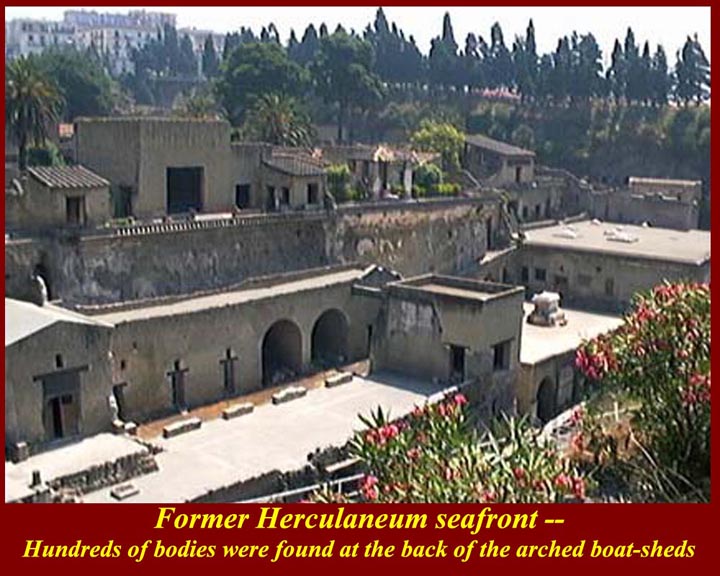
http://www.mmdtkw.org/ALRIVes0405oSeafront.jpeg
The view is from the top of the sixty-foot-deep volcanic overlay
down into the area that was the pre-79 AD waterfront. The
arches are entrances to boat sheds -- where hundreds of sets of
human remains have recently been found. The sheds are
currently under active excavation and are not open to the
public.
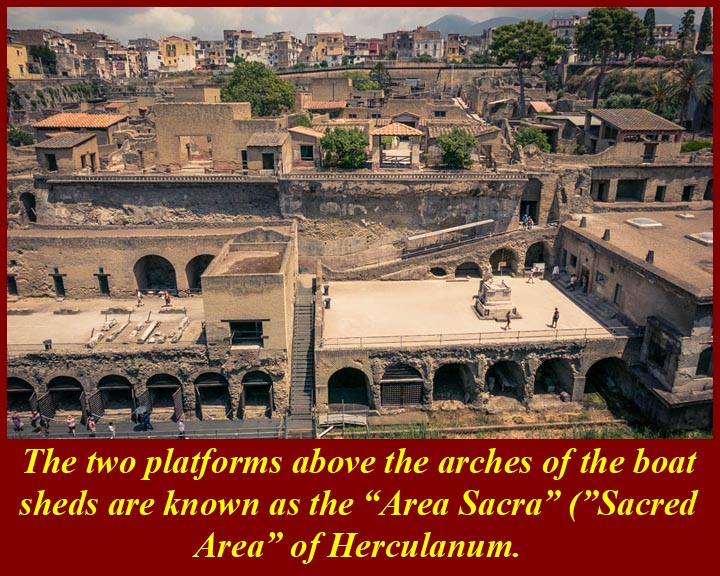
http://www.mmdtkw.org/ALRIVes0405pAreaSacra.jpg
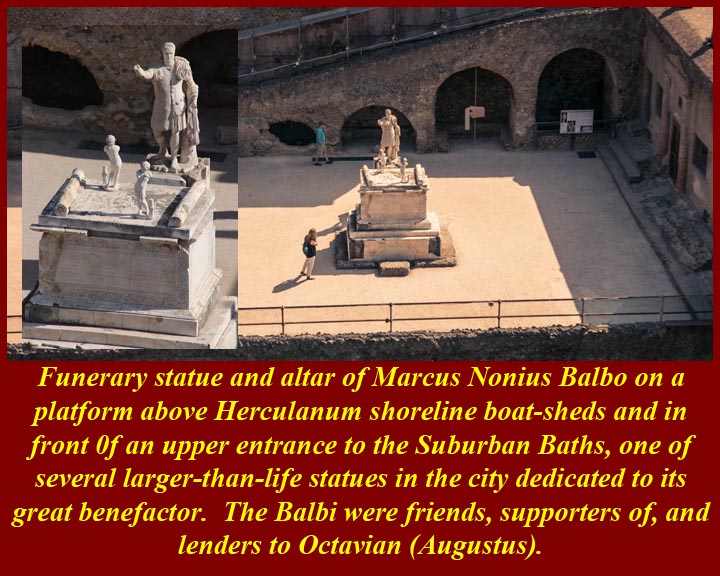
http://www.mmdtkw.org/ALRIVes0405qMNoniusBalbaStatue.jpg
Judging by the statues of Balbus and the dedicatory inscriptions
around town, by the time of the 79 AD eruption he was
Herculanum's greatest benefactor.
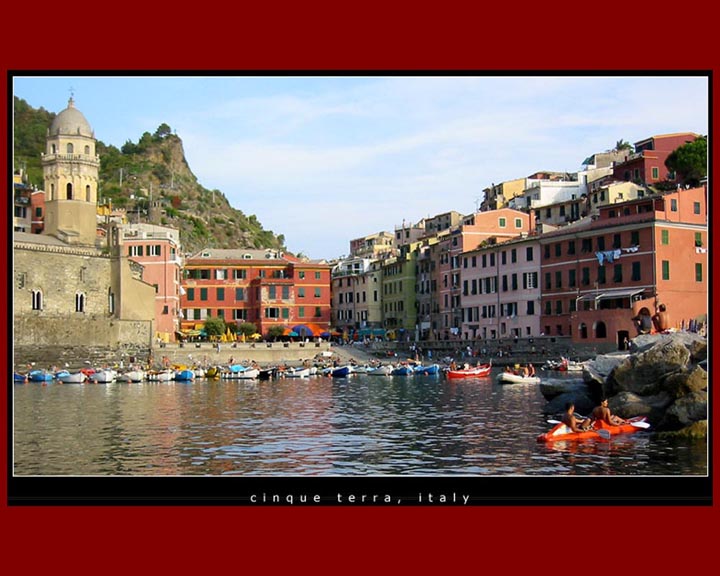
http://www.mmdtkw.org/ALRIVes0406Cinqueterra.jpg
Not on the Bay of Naples, but rather the Cinque Terra much further
up the coast in Liguria -- included here as an indicator of the
assumed Herculaneum lifestyle. From literary and
archeological sources, we believe that Herculaneum was more of a
tourist and resort town than was Pompeii. The excavated
and tunneled areas of Herculaneum were close to the shore, where
the rich folks lived and tourists partied, so they may give a
skewed impression of the character of the community.
Probably, like the Cinque
Terra towns, Herculaneum had "real" neighborhoods a few
blocks inland, where the locals lived.
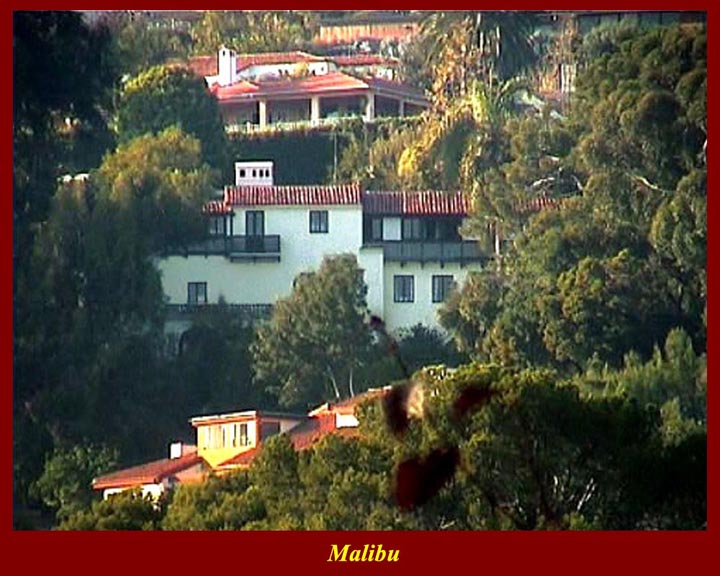
http://www.mmdtkw.org/ALRIVes0407Malibu.jpg
Another coastal community where villas of the rich line the
shore. This one is Malibu, California, where one of the
best-preserved Roman villas is still standing.
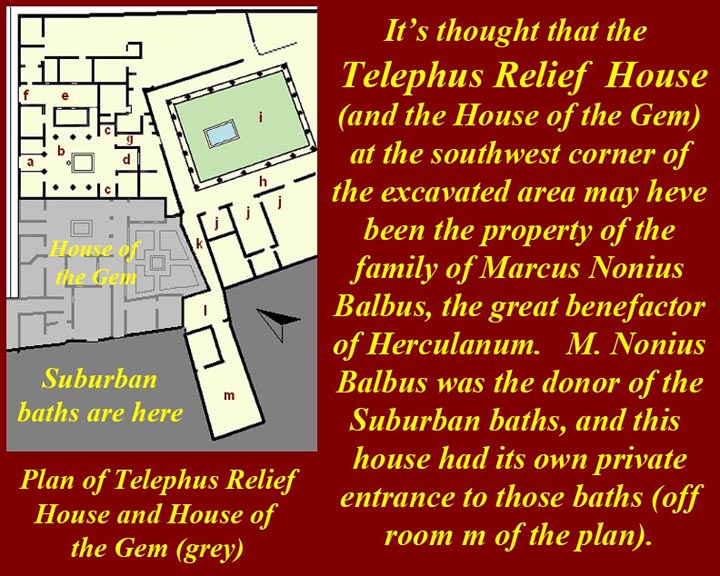
http://www.mmdtkw.org/ALRIVes0407qTelephusReliefHousPlan.jpg
The Balbus family, Herculanum's preeminent benefactors, are
thought to have owned the compound (made up of several earlier
properties) at the southwest corner of the excavated aree and
adjacent to the "Suburban Baths", which M. Nonius Balbus had
donated to the City.
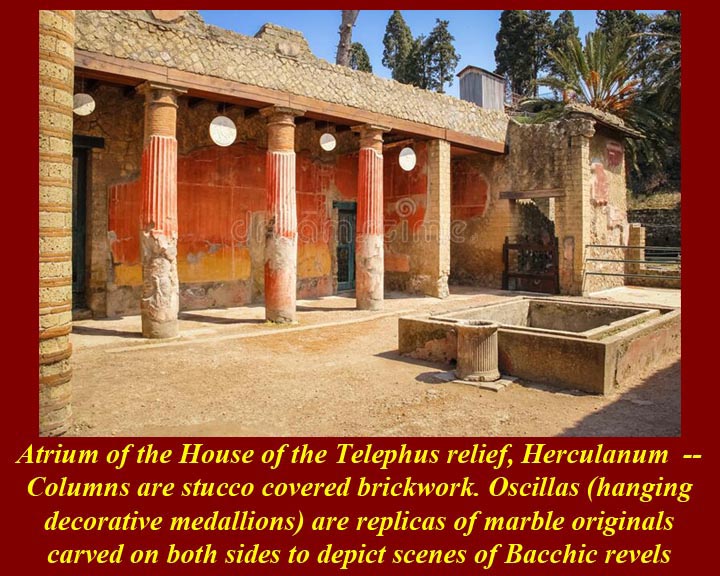
http://www.mmdtkw.org/ALRIVes0407rTelephusHouseAtrium.jpg
The was the house is presented now in the ruins of Herculanum,
it's hard to understand that the columns around the atrium did
not just prove a walkway around an open courtyard. In
fact, they supported the second storey balcony with whole suites
of rooms behind it, and above the second storeu was an inward
slanted tile compluvium roof from which rainwater drained into
the impluvium pool shown and thence into the underground cistern
below the impluvium.
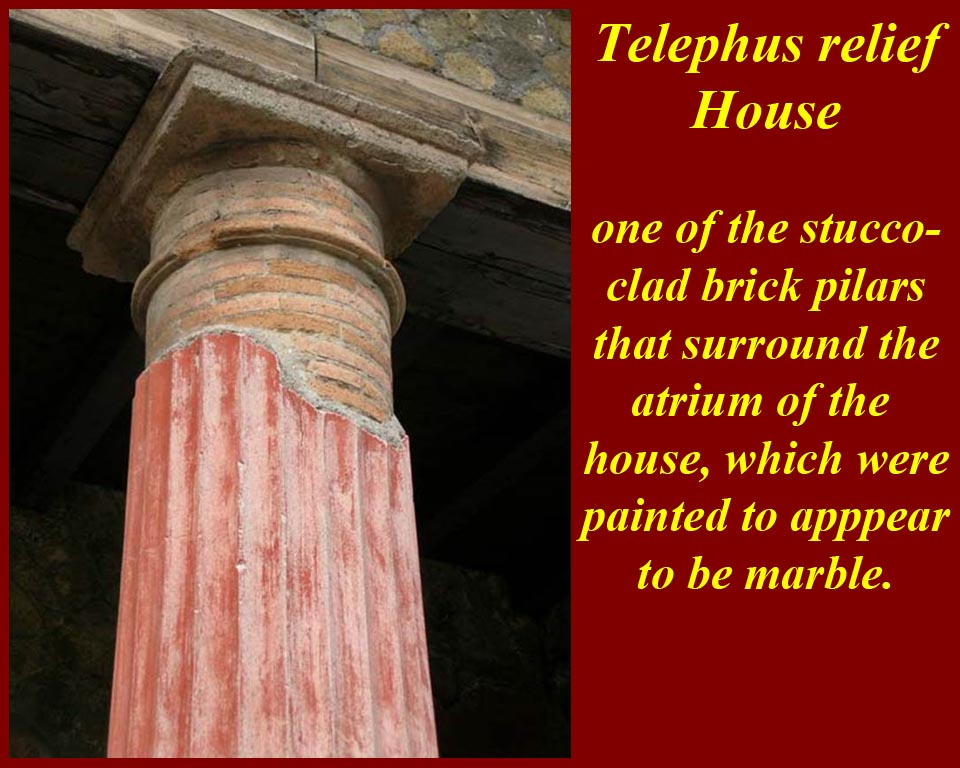
http://www.mmdtkw.org/ALRIVes0407sTelephusPillar.jpg
Although the Balbus family was undoubtedly rich, they weren't
averse to saving a few denarii on corstruction costs. The
deluxe red marble collumns around their atrium turned out to be
faux -- brick covered in stucco and painted to look like real
marble. They are built just like the atrium collumns
in the post-Civil War building in Washington DC that now houses
the US National Building Museum.
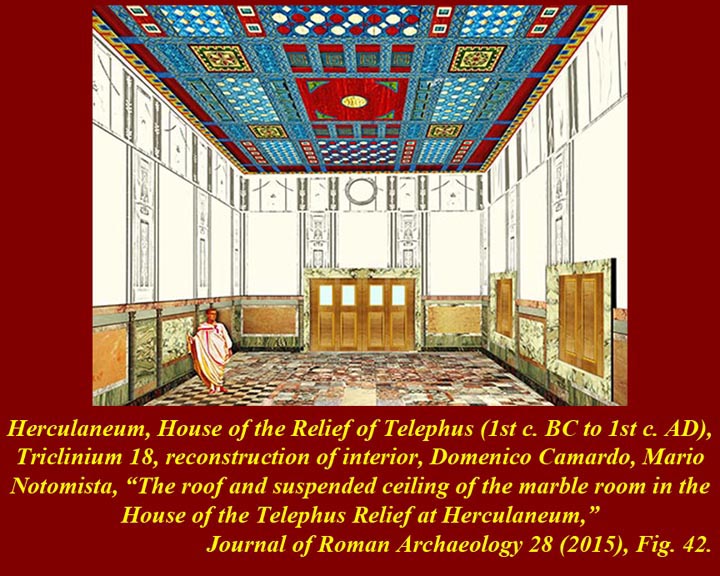
http://www.mmdtkw.org/ALRIVes0407tTelephusTricliniumReconst.jpg
Until the ruins of this room in the Telephus Relief House were
uncovered, nobody knew that the Romans (at least the
Herculaneans) knew how to build suspended ceilings like the one
illustrated here. They were thought to be another Italian
Renaissance invention. It appears, however that the
architectural knowledge was actually lost and was, in fact,
reinvented during the Renaissance -- there are no known European
examples between this on and the suspended ceiling of the
Renaissance.
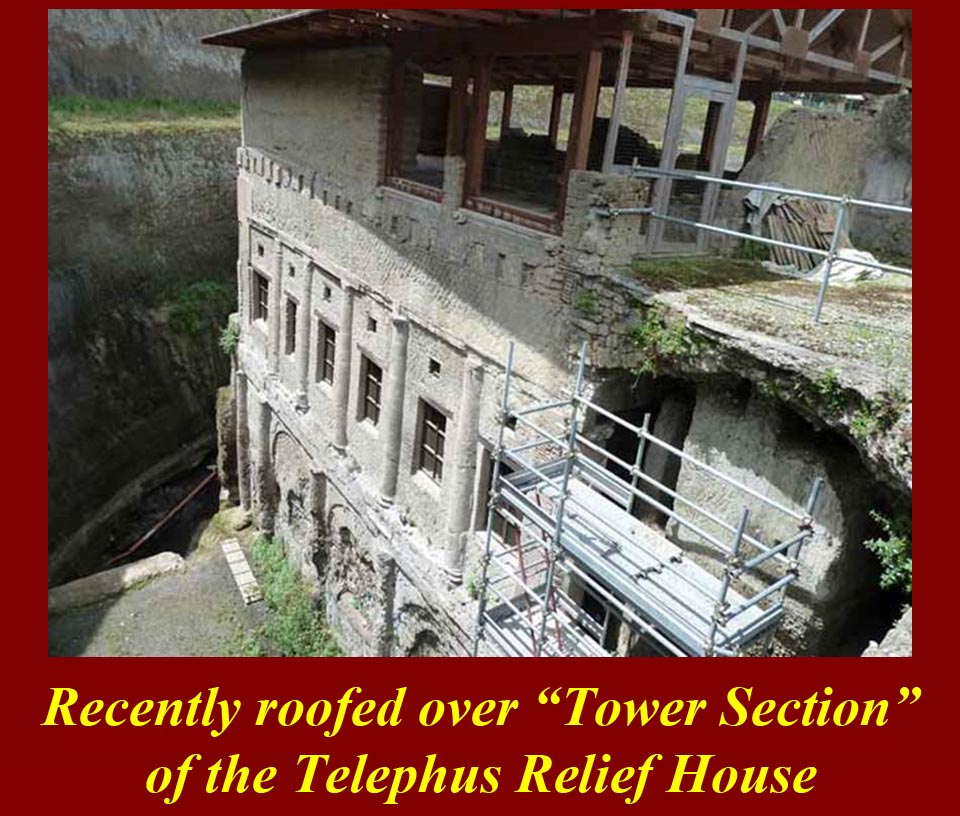
Http://www.mmdtkw.org/ALRIVes0407uTelephusTower.jpg
Because of its location and the lay of the land, multiple levels
of the House of the Telephus Relief survived (southwest corner
of town, away from the volcano, lowest level on the beach two
floors below city level).
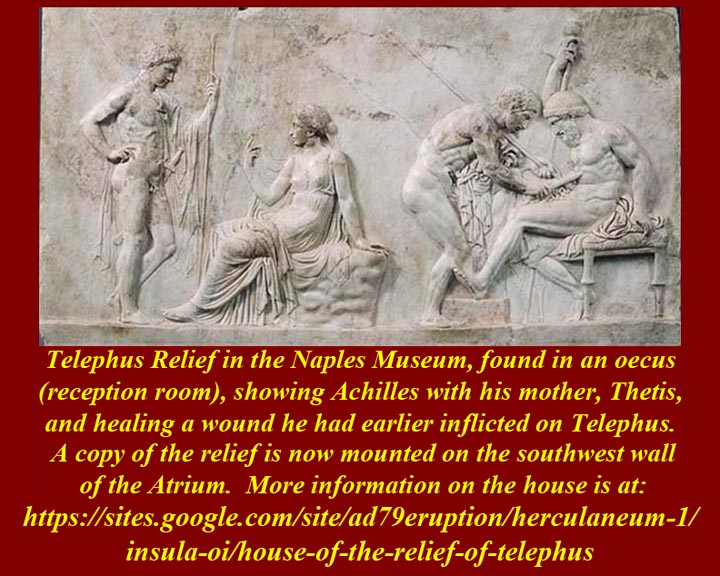
http://www.mmdtkw.org/ALRIVes0407vTelephusRelief.jpg
The relief is sometimes identified as an Achilles piece, but the
archeologist decided to identify it and the house by the lesser
known character.
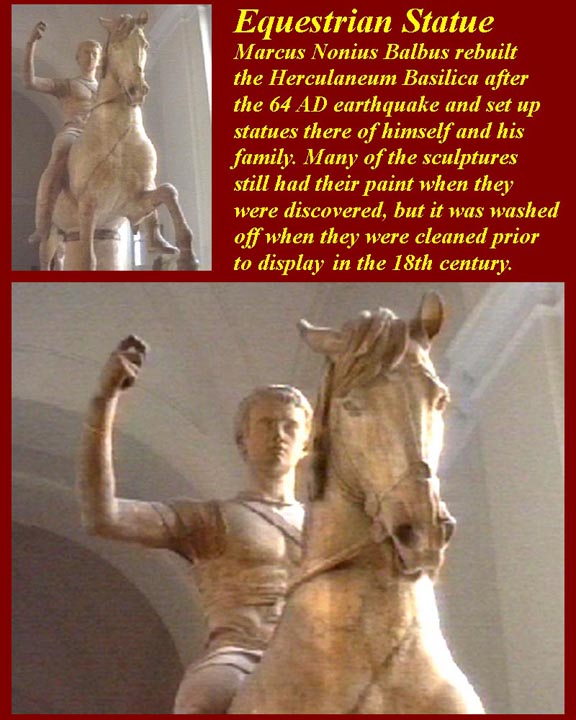
http://www.mmdtkw.org/ALRIVes0407wBalbusBasilicaEquestrian.jpg
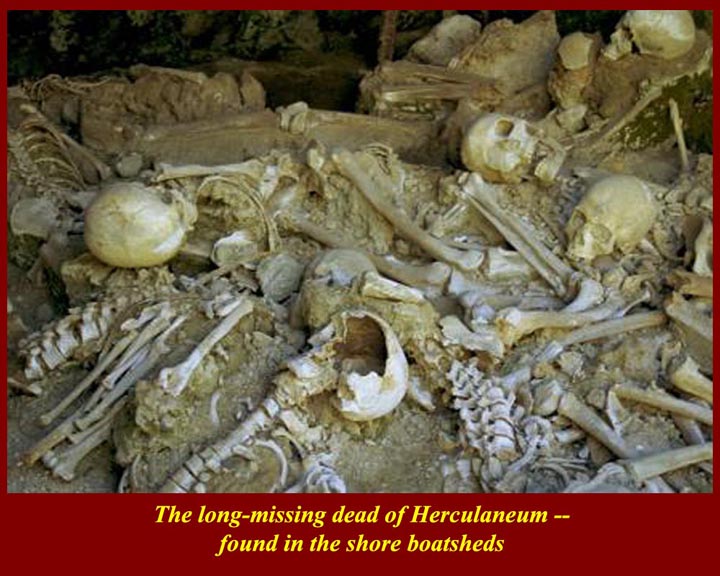
http://www.mmdtkw.org/ALRIVes0408Skeletons.jpg
For many years, archeologists thought that the population of
Herculaneum had evaded the reaper and just got out of town
before the Peleean phase of the 79 AD eruption began. In
recent years, jumbles of their bones have been found at the back
of those shore-line boat sheds. It's not known whether
they were hiding as far away from the entrances as
possible or whether the force of the pyroclastic blast threw
them to the back of the caves. We, of course, know that
it's possible to survive such a blast in a cave -- haven't we
all seen Dante's Peak
and other hollywood eruptions?
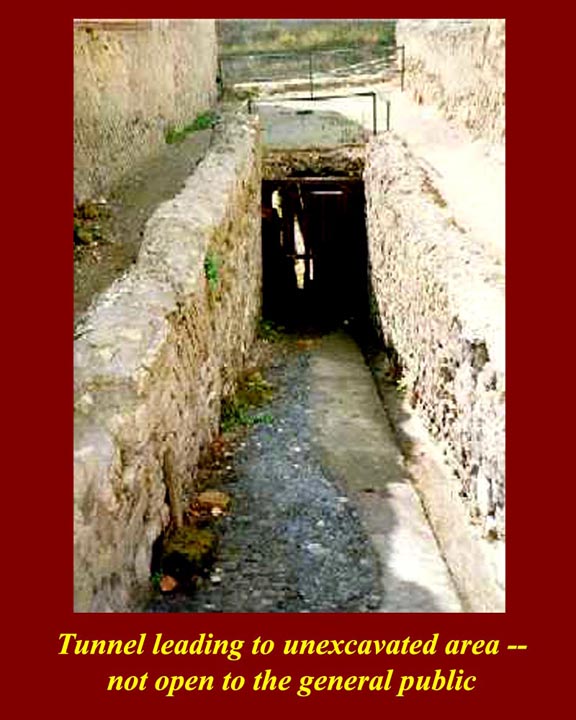
http://www.mmdtkw.org/ALRIVes0409CardoTunnel.jpg
At the ends of the excavated sections of Herculanese streets
there is usually a cut into the rock that ends with a locked
iron grate or doorway. In past years, it was possible to
bribe your way past the gates (still is if you bribe high
enough, both in terms of who and how much to bribe), but the
general public kept out. The days are long gone when
casual guides had keys that could get you under ground.
The real reason the passages are closed is just the one the
officials tell you: they have been neglected and are no
longer safe. Some passages are flooded, some have caved
in, and, yes, poisonous volcanic gas still accumulates.
Just as importantly, as tourist numbers go up, it's harder to
keep track of all of them. Even if you find an open
tunnel, it's really not a good idea to go in: the
tunnels are also haunted, according to local lore.
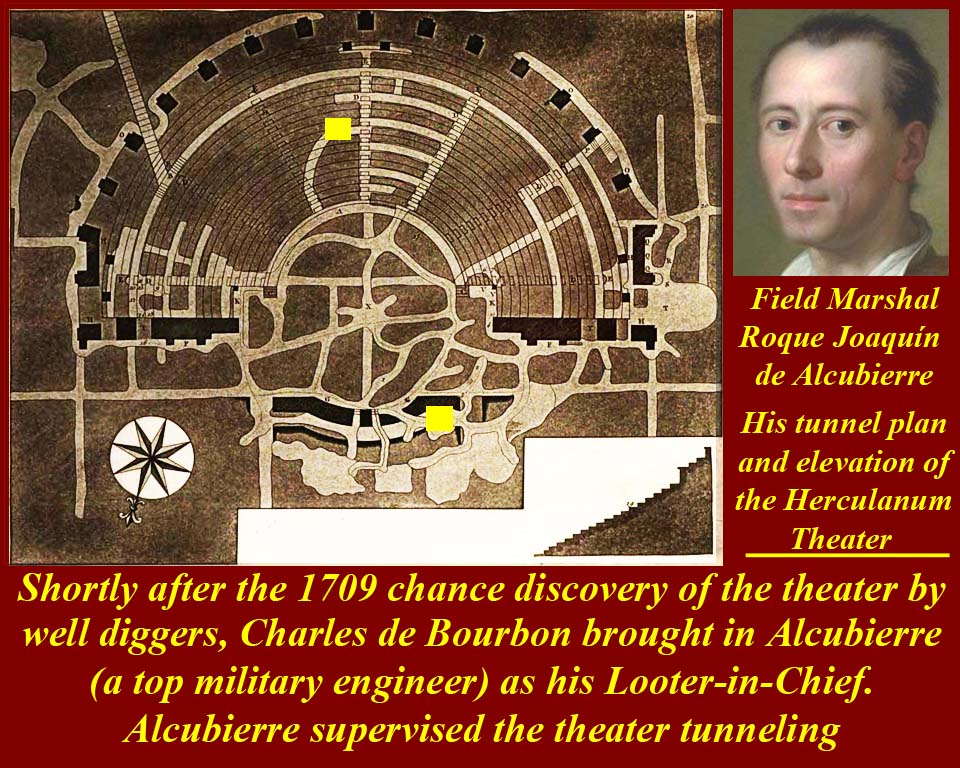
http://www.mmdtkw.org/ALRIVes0410aTheaterPlanAlcubierre1747.jpg
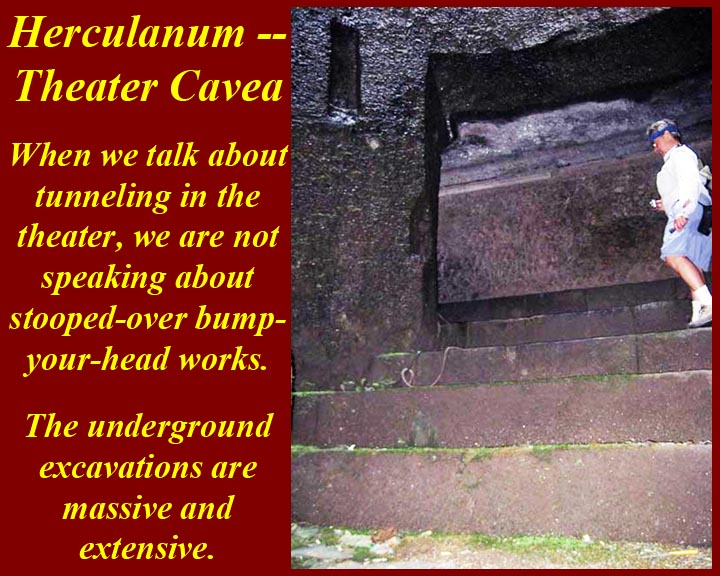
http://www.mmdtkw.org/ALRIVes0410bTheaterCavea.jpg
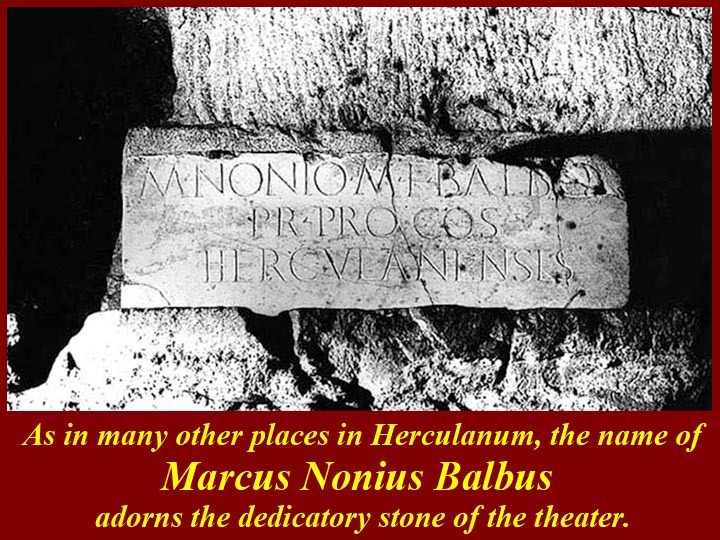
http://www.mmdtkw.org/ALRIVes0410cTheaterBalbiDedication.jpg
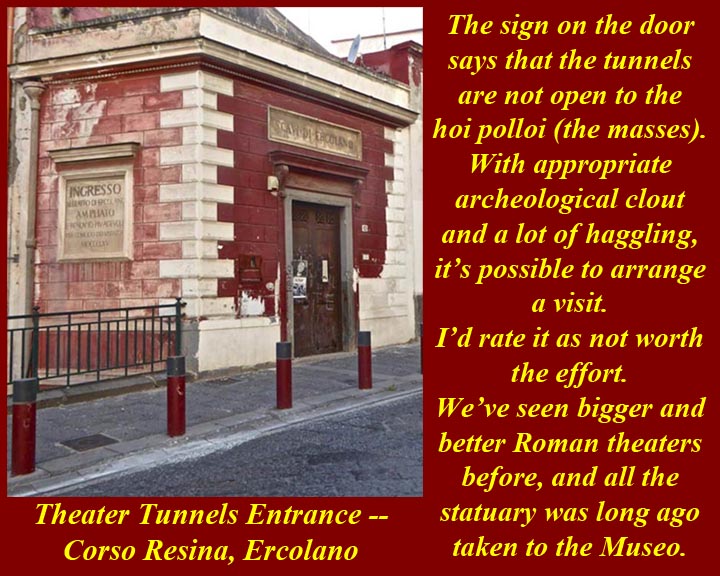
http://www.mmdtkw.org/ALRIVes0410dTheaterEntranceCorsoResina.jpg
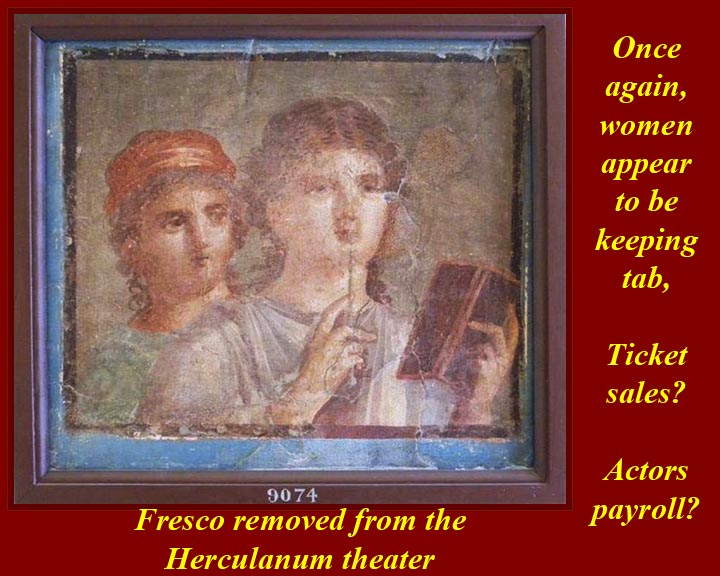
http://www.mmdtkw.org/ALRIVes0410eTheaterFresco.jpg
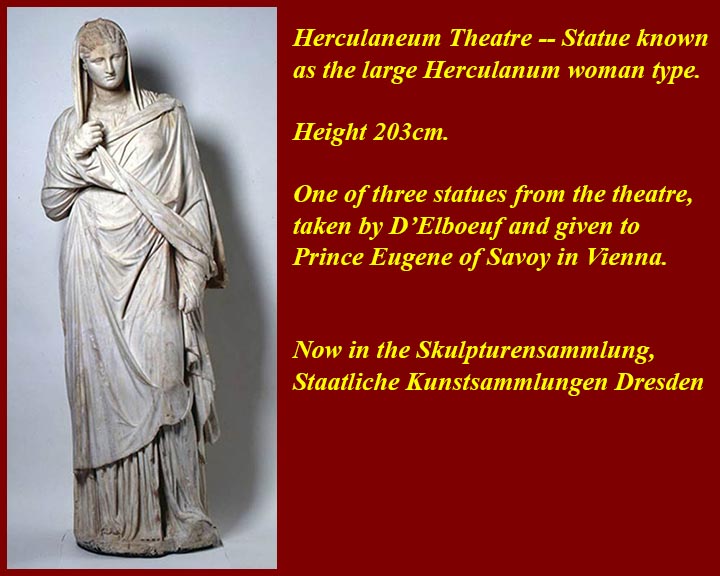
http://www.mmdtkw.org/ALRIVes0410fTheaterLargeWomanStatue.jpg
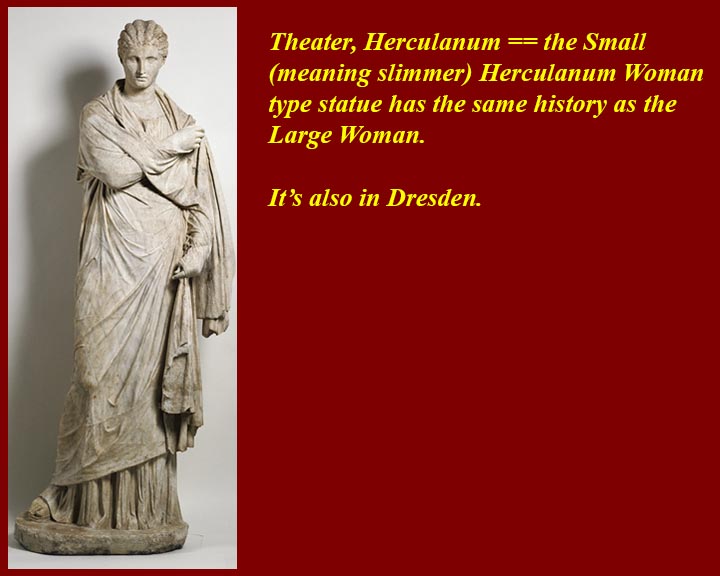
http://www.mmdtkw.org/ALRIVes0410gTheaterLSmallWomanStatue.jpg
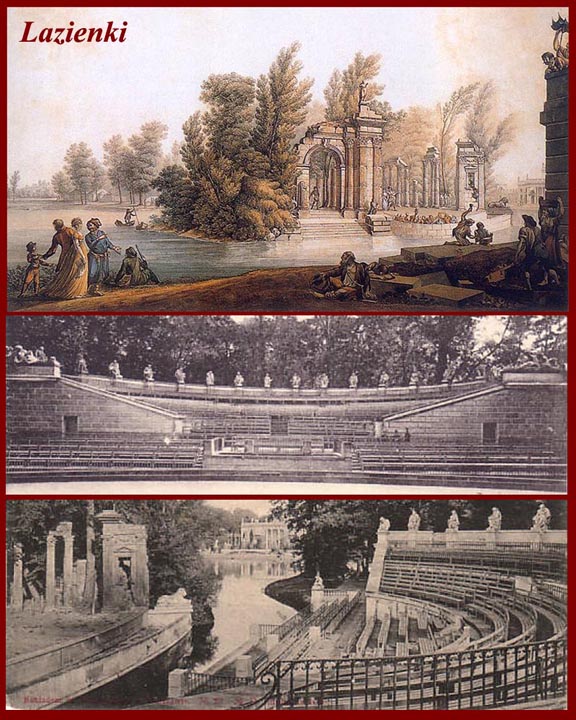
http://www.mmdtkw.org/ALRIVes0410LazienkiTeatr.jpg
The tunnels to the theater are all closed, and there's no money
to make them safe and open them again. But you can still
see the theater, or at least a reasonable facsimile. King
Stanislaus Poniatowski built a replica of the theater on his
palace grounds in Warsaw in the 18th century, shortly after the
Herculaneum theater was explored. He made a few
changes: the stage is on an island and the semi-circular
cavea (seating) is on shore while the orchestra is a flooded
former bed of a branch of the Vistula River. Stanislaus
built his theater to look like the Herculaneum theater was found
by the diggers, not as it looked before the eruption. The
outdoor Warsaw theater has a lively summer season and is now
called either the Lazienki Theater or the Chopin Theater in
Lazienki Park.
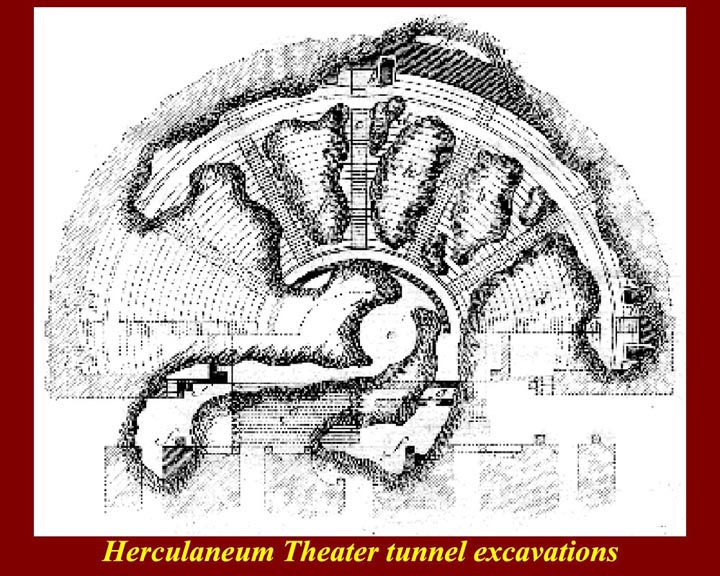
http://www.mmdtkw.org/ALRIVes0411HercTheater.jpg
A drawing of the tunnels into the Herculaneum Theater from the
18th century. Alcubierre headed the tunneling effort, and
his main goal was to find statuary for the palace of the King of
Naples -- statues that are now in the National Archeological
Museum in Naples.
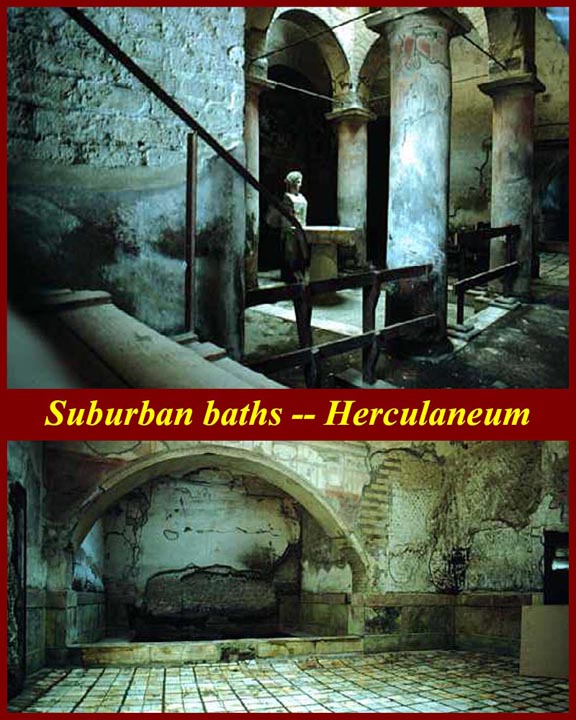
http://www.mmdtkw.org/ALRIVes0412BathsSuburban.jpg
Four public baths were discovered Herculaneum. Two
are in the excavated area, one set is tunneled, and the fourth
was refilled with rubble from additional tunneling. The
two that are accessible are called the Urban Baths and the
suburban baths. Because of its location, the suburban
baths are better preserved. In this picture the entrance
shrine -- almost like a "holy water" font in a Christian church
-- is visible. Romans entering the baths were expected to
sprinkle themselves and the statue in remembrance of the
original ritual purpose attached to bathing. The lower
half of the picture is the calidarium or hot room.
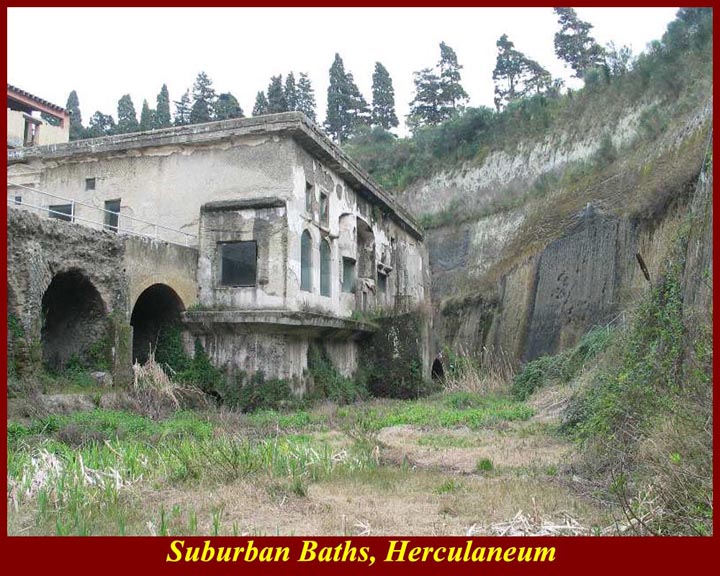
http://www.mmdtkw.org/ALRIVes0413SuburbanBaths.jpg
The exterior of the Suburban baths is in surprisingly good
repair. Unlike the Urban (or Forum) baths, the suburban
baths did not have separate sections for men and women.
It's assumed that men and women came at different times or on
different days. Later in the Roman imperial period, mixed
bathing became common, but there were occasional decrees against
it. The repetition of such decrees indicates that mixed
bathing must have persisted. Roman baths mostly faded away
in the Western Empire after aqueducts that fed them were damaged
by invaders and there was no longer enough local manpower to put
them back into repair (but there are still some in use -- Tivoli
near Rome for example). In the Eastern Empire they
were redecorated over the centuries and became "Turkish baths".
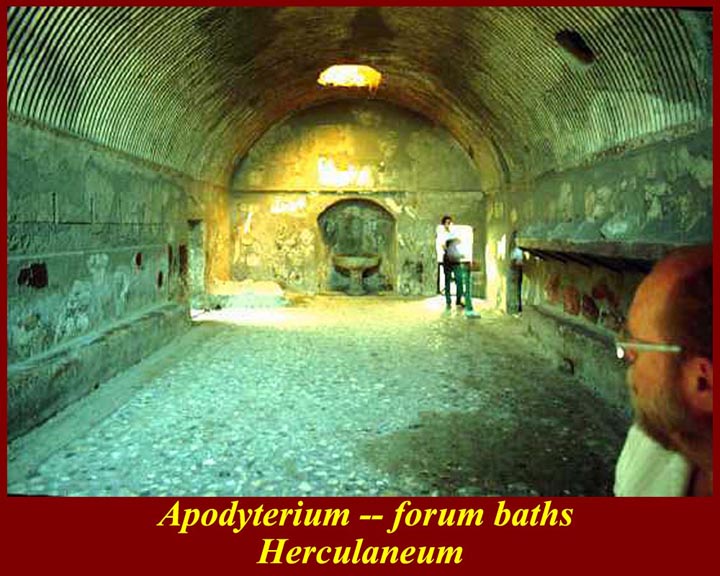
http://www.mmdtkw.org/ALRIVes0414MensBathApodyterium.jpg
The Forum or Urban Baths had separate sections for men and
women. This is the men's changing room -- a partitioned
shelf along each side was where bathers' clothing was
stacked. One of the shelves is missing, but the marks
where it was hung are clearly visible. Public baths
usually opened late in the morning and stayed open until sunset,
but if there was greater demand, the would open earlier and stay
open later at night, lit by oil lamps.
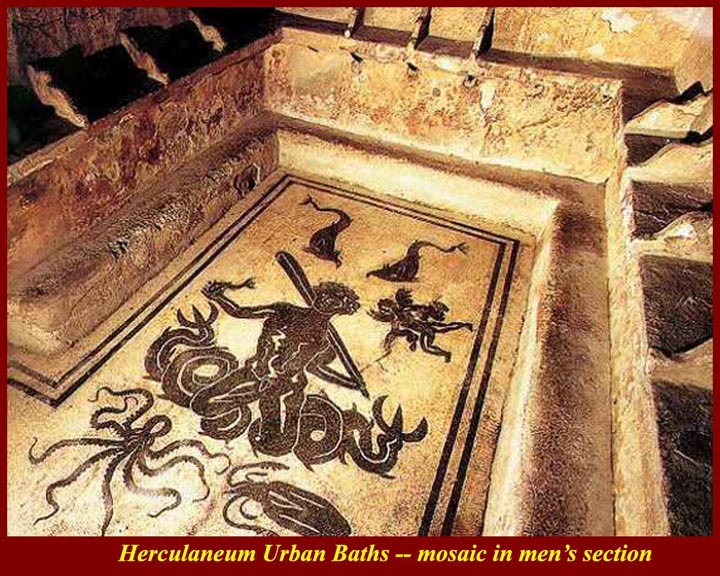
http://www.mmdtkw.org/ALRIVes0415BathMosaic.jpg
A resting area ("conversation pit"?) with a suitably watery
mosaic. This one, in fact, is one of the better --
and therefore more famous -- Roman mosaics to come from the
Campania Region. There were better ones in Rome, but the
best are in North Africa where Roman nobles built fine resort
villas and where imperial officials fattened on local
corruption. The next image is North African Roman, for
comparison.
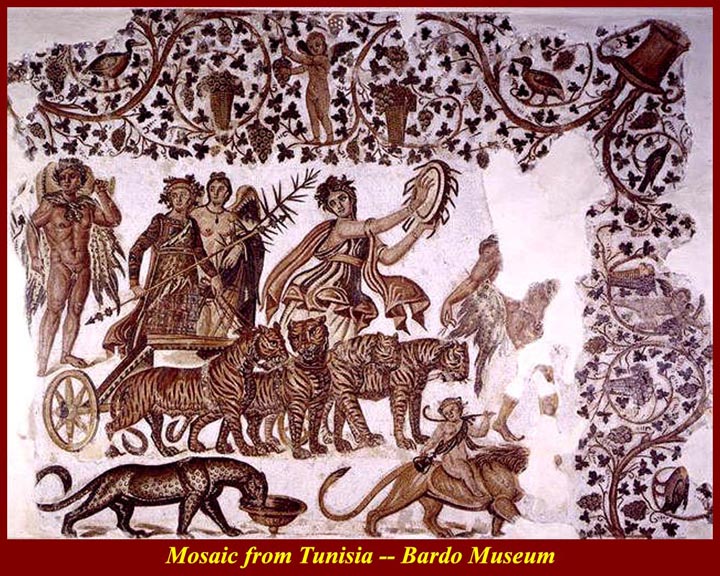
http://www.mmdtkw.org/ALRIVes0416MosaicTunisi.jpg
The Tiger Mosaic from Roman Carthage is now in the Bardo Museum
in Tunis City, Tunisia. The Bardo, without question, has
the best collection of Roman mosaics, all local North African
finds.
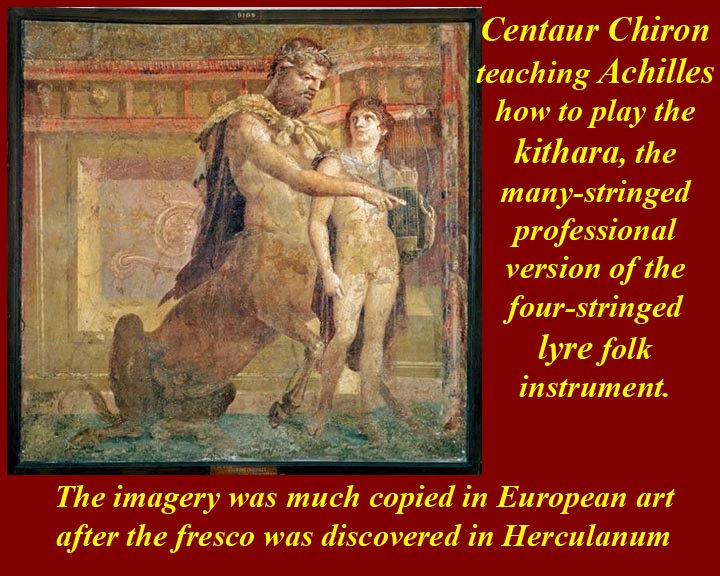
http://www.mmdtkw.org/ALRIVes0416vChironAchilles.jpg
The imagery is considered to be sexual; the Roman tutor was
expected to initiate his pupil, first in their homosexual
relationship, an then, when the boy approached the age of
citizenship (13 or 14 years old) to help him find/hire his first
heterosexual partner. Chiron appears to be plucking the
strings of the Kithara, but everyone knew that the kithara was
not the only thing he plucked. Actual physical intimacy
with a centaur? Boggles the mind.
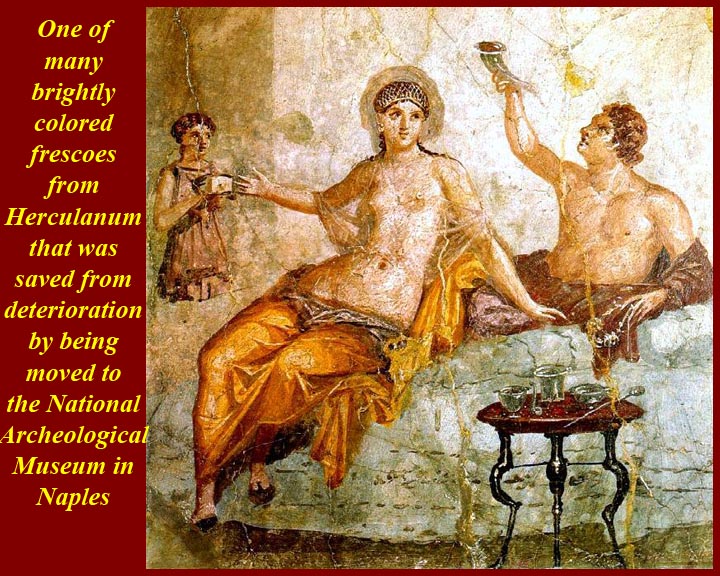
http://www.mmdtkw.org/ALRIVes0416wBanquet
fresco.jpg
Called by the prudish excavators a "banquet scene" it's clearly
something else. The diminutive slave girl in the
background is using her iPhone to take pictures.
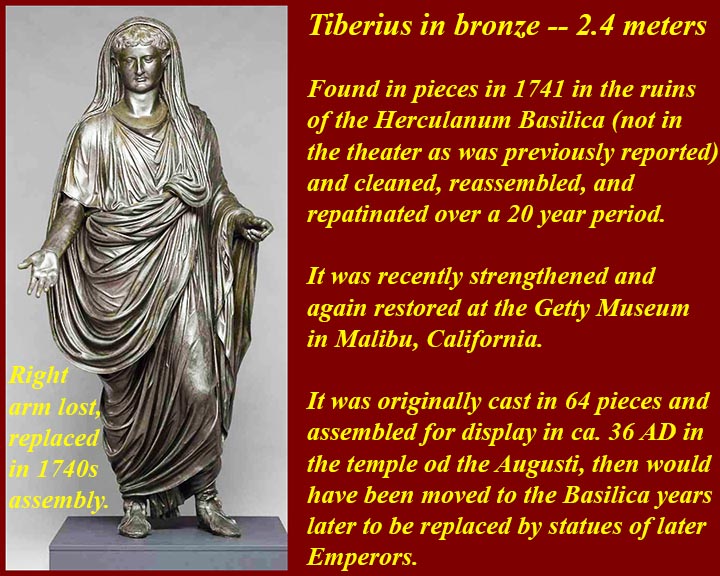
http://www.mmdtkw.org/ALRIVes0416xTiberiusBronzeRestoredBasilica.jpg
This and the following image show finds from the Herculanum
Basilica.
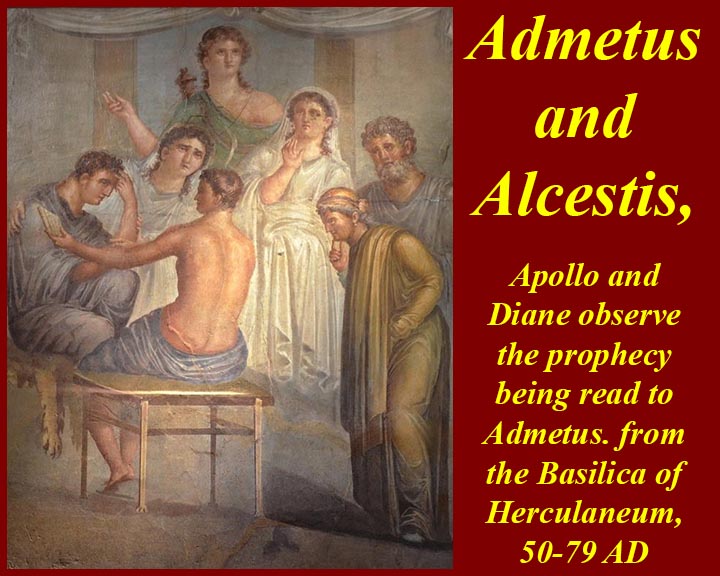
http://www.mmdtkw.org/ALRIVes0416yAdmetusProphecyBasilica.jpg
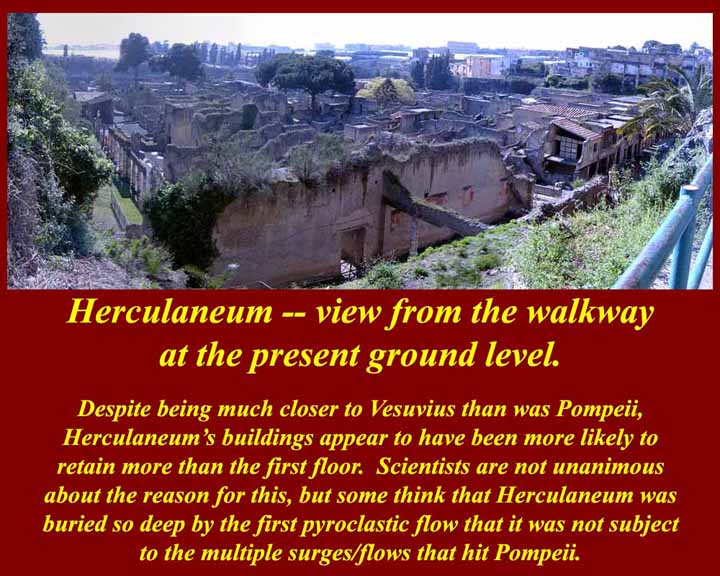
http://www.mmdtkw.org/ALRIVes0417TwoStoreyRuins.jpg
As mentioned above, many more buildings in Herculaneum seem to
have retained their upper floors. Various theories -- none
of them certain -- have been offered as to why this is so.
Perhaps the terrain deflected the ground-hugging pyroclastic
surges that did so much damage elsewhere, or perhaps the
buildings in Herculaneum were more structurally sound not having
been burdened with the weight of the heavy ash fall, which
landed on Pompeii, or perhaps the buildings were just stronger
to begin with. Some experts say the pyroclastic flow just
arrived so fast that the quick buildup around the buildings
actually supported them. Whatever the cause, Herculaneum,
although much smaller than Pompeii, has yielded much more
information about upstairs life. Among other things found
were sets of legal documents in three of the upstairs rooms in
the first row of houses on the right side of the picture, among
them a case involving whether a person was freeborn or slave and
another pertaining to the application of a freedman to join the
Augustales priesthood, those who maintained the temple of the
Imperial cult.
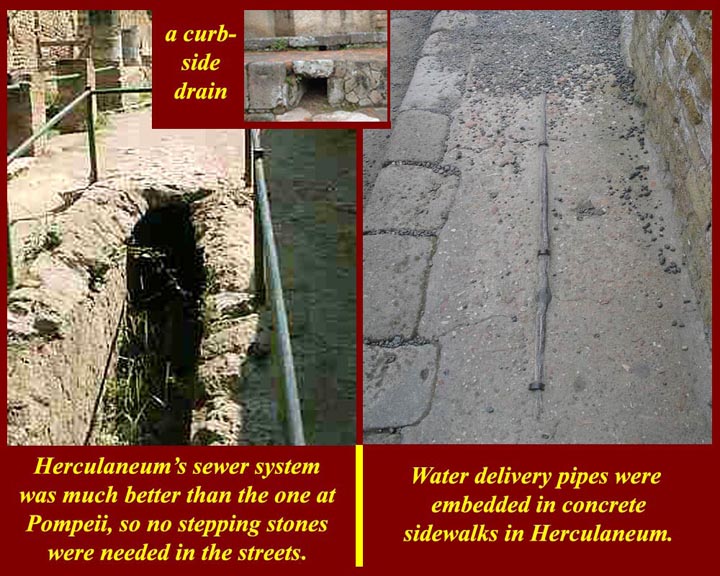
http://www.mmdtkw.org/ALRIVes0418WaterSewer.jpg
Roman water and sewerage works were usually quite
sophisticated. Pompeii had rainwater drainage problems and
therefore needed those famous stepping-stones for crossing from
one side of the street to the other -- the modern equivalent are
the raised wooden walkways used in Venice during "high
water." The absence of stepping stones in Herculaneum
points to better rainwater management. Sewers ran beneath
the streets in Herculaneum, and there were drains along the
curbs, much like those in the Washington DC area. Fresh
water delivery was through lead pipes, which were often embedded
in concrete sidewalks. Examples of sewer and water
delivery lines are shown in the picture.
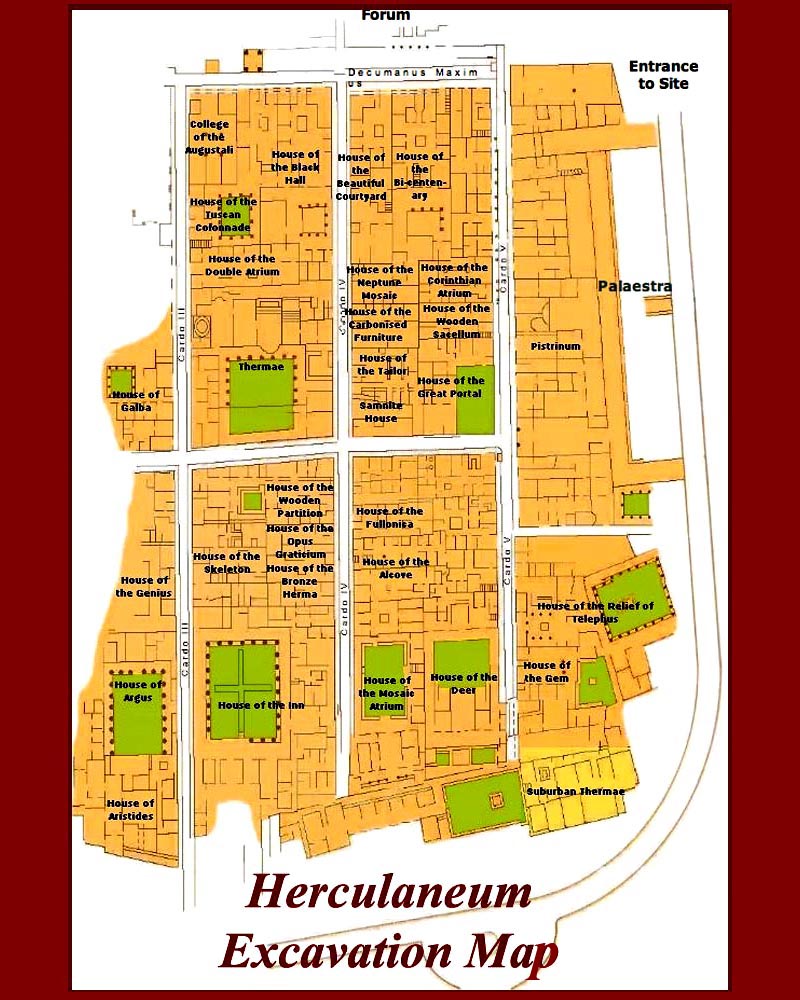
http://www.mmdtkw.org/ALRIVes0419HercExcavMap.jpg
The important buildings in the excavated area are all mapped
out for tourists, and all can be seen by a casual visitor in a
few hours. The really, exciting stuff is in tunnels which
are off-limits. As with Pompeii, much of Herculaneum's
best art is in the National Archeological Museum in Naples.
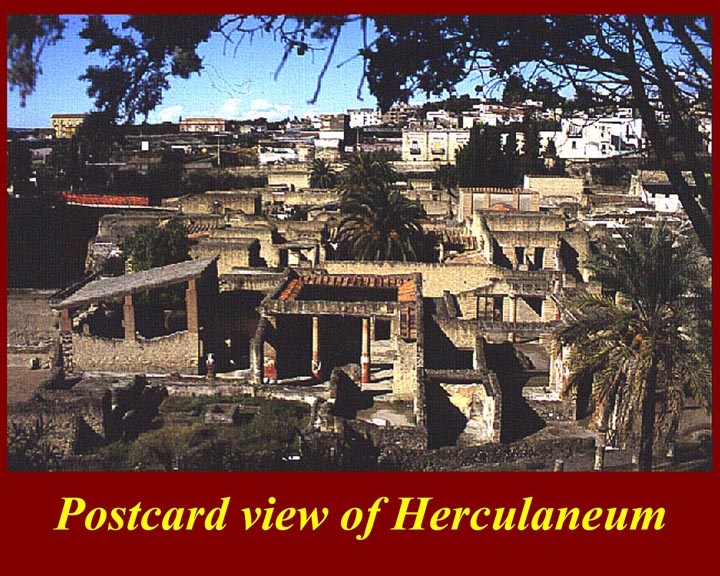
http://www.mmdtkw.org/ALRIVes0420hercosik.jpg
Every set of archeological pictures needs one of these shots
with a leafy bough hanging over the top.
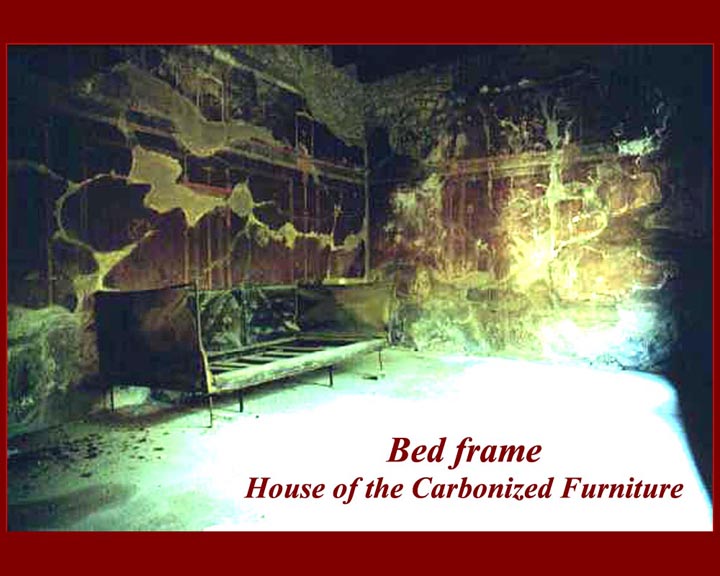
http://www.mmdtkw.org/ALRIVes0421CarbonizedFurnHouse.jpg
Like the houses in Pompeii, those in Herculaneum got their names
mostly by what archeologists found inside. There was a lot
of carbonized furniture to be found, and some of it was left
intact when the treasure hunters swooped through. The
major part of the real Herculaneum excavations -- i.e., earth
removal rather than tunneling -- was done under the supervision
of serious scholars while the royal treasure hunters were
tunneling elsewhere for gold and statuary.
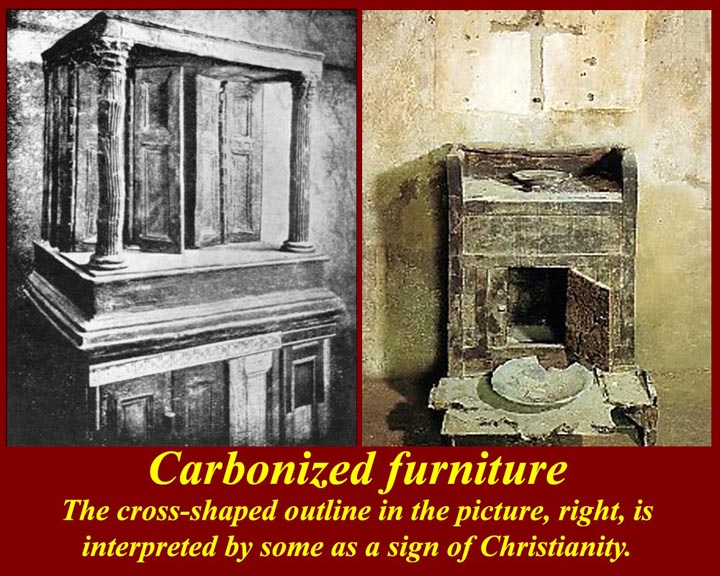
http://www.mmdtkw.org/ALRIVes0422CarbonizedFurniture.jpg
Examples of Herculaneum cabinetry. The piece on the right
has attracted particular attention as a wished-for Christian
shrine -- above it was found pretty much the only cross-shaped
outline in the ruins. Never mind that the cross was, until
several centuries later, not used in Christian iconography -- it
was considered a shameful and disgraceful image. Christ
was, in those early years, always shone with the iconographic
symbols of Apollo, and, if we can believe the Gospels, he
himself used some Apollo imagery to describe himself. The
"Light of the World" was Sol Invictus or Apollo. In
addition, the Christians had no monopoly of executed or even
crucified saviors -- see http://altreligion.about.com/library/weekly/aa052902a.htm
for relevant non-Christian iconography and parallels. Like
most archeologists, I think the cross-shaped outline is a place
where a standard shelf bracket was attached over a dry sink,
which is what the piece of wooden furniture is.
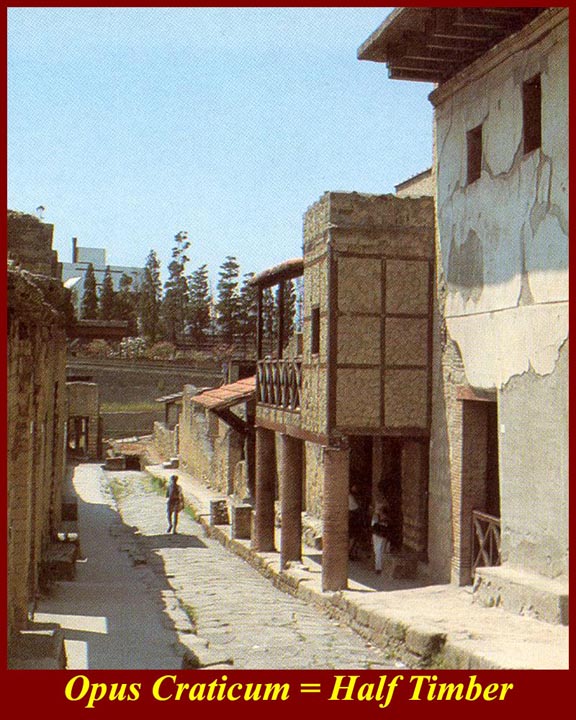
http://www.mmdtkw.org/ALRIVes0423OpusCraticum.jpg
Opus craticum was what we would call half-timbering, and it was
done the same way from pre-roman times until the mid 20th
century when the look was kept but the process was
abandoned. In opus craticum a wood frame was built and
then laths or sticks were strung between the framing
members. Stucco (plaster) was applied to both sides of the
lath, and then whitewashed. The Romans had some really
good hydraulic plasters for water-proofing, but little better
than mud was used most of the time for opus craticum.
What's remarkable here is not the work but that the flimsy and
shoddy construction survived the eruption. There may have
been a lot more of this stuff around in the upper floors of
ancient Roman buildings, but little survived except this
carbonized example. Most of what you see at the site is
19th and 20th century reconstruction.
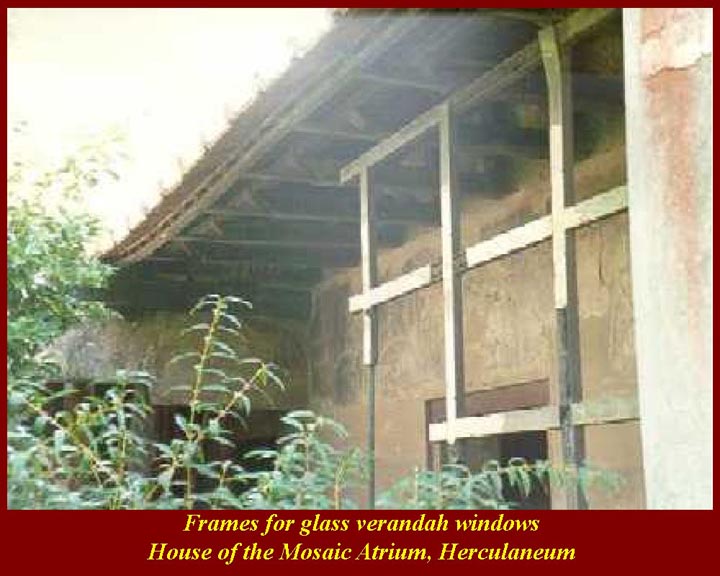
http://www.mmdtkw.org/ALRIVes0424GlassVerandahFrames.jpg
The Mosaic atrium house got its name from the complex geometric
mosaics in the atrium and connecting rooms, but the most
remarkable feature of the house, not recognized until the other
name was attached to it, was the glass enclosed verandah.
If anyone ever asks if the Romans had glass windows, this is the
showpiece. Big wooden frames held big panes of
glass. The glass, of course, did not survive intact, but
most of the frames are still there as charcoal. They
carbonized frames are now mostly sheathed in plastic for
protection against the elements.
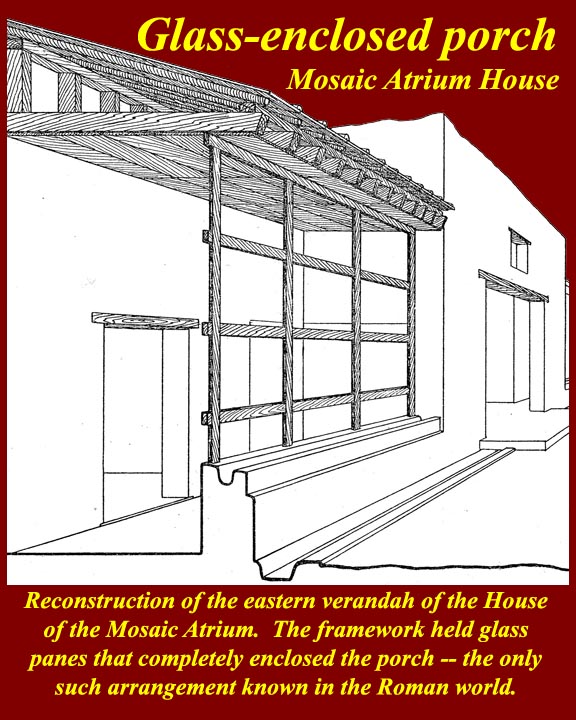
http://www.mmdtkw.org/ALRIVes0425GlassEnclosedVeranda.jpg
The same veranda in an isometric drawing showing drainage
channels that carried water from the windows to the ground-level
garden outside. It was really a remarkable piece of work
and the only thing of its kind to survive from the Roman world
or anywhere else around the Mediterranean of that time.
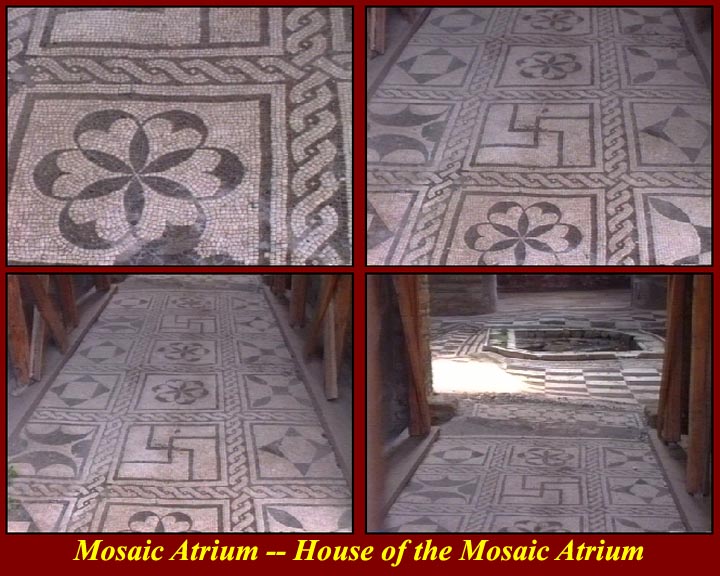
http://www.mmdtkw.org/ALRIVes0426MosaicAtrium.jpg
The mosaics are extensive, well designed, and well
executed. most of the ensemble is in very good condition
although right around the impluvium in the center of the atrium
the floor is badly warped.
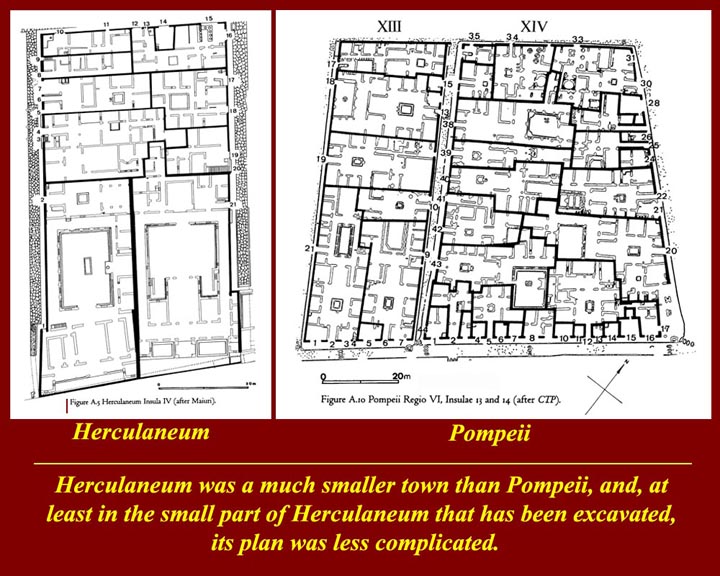
http://www.mmdtkw.org/ALRIVes0427HercPompLayout.jpg
Herculaneum, at least the part that has been explored or
excavated, has a much more open pattern than Pompeii. It
appears to have been a rectangular-planned town rather than one
that grew haphazardly like Pompeii on uneven terrain.
There were fewer buildings per block (insula) and less mixing of
residential, commercial, and industrial space use. This
may, however, be a function of which section of Herculaneum has
been explored -- blocks further back from the sea front may be
more mixed. From all appearances, however, Herculaneum was
really just a resort for the rich (as it was described in
contemporary sources) with just enough commercial activity --
corner groceries, etc. -- to keep the resident nabobs
happy. Think of the resort towns on the barrier islands on
the US Atlantic coast -- without the hurricanes, but with the
occasional volcanic interruption
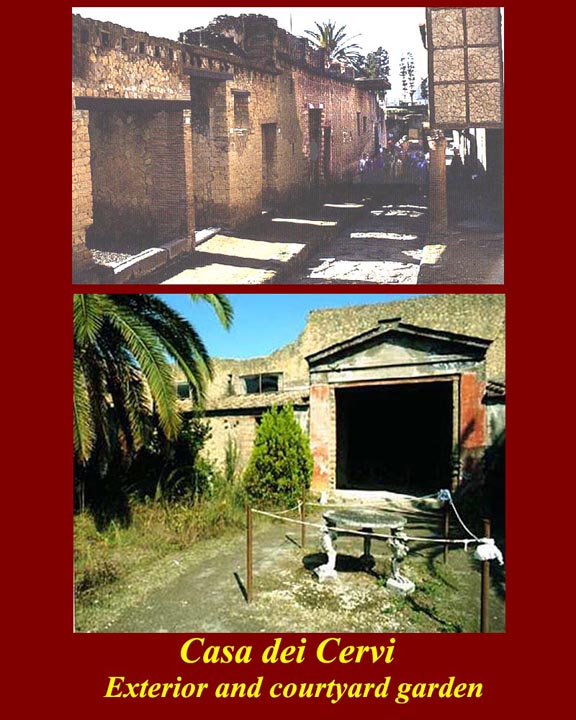
http://www.mmdtkw.org/ALRIVes0428CasaDeiCervi.jpg
The House of the Deer (Casa dei Cervi) was so named for a statue
in the garden. The exterior, as it is today is
unremarkable, but it was a very rich house with two separate
courtyard gardens and, of course, its impressive statuary --
especially the deer.
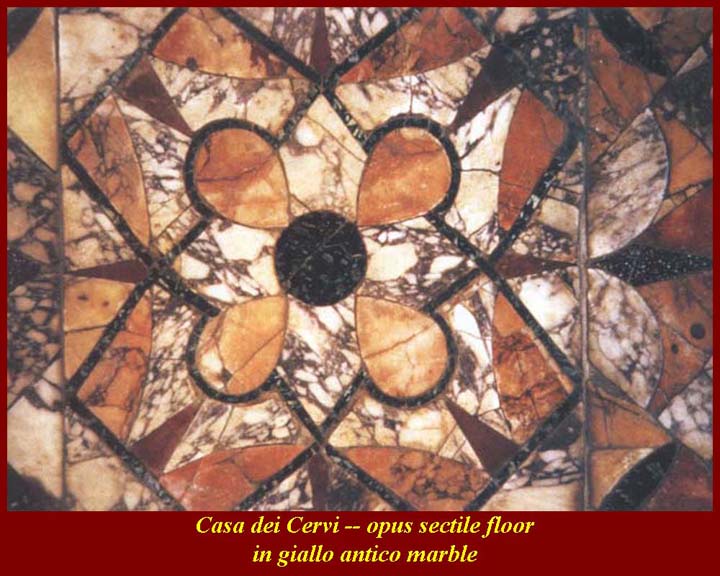
http://www.mmdtkw.org/ALRIVes0429OpSectileCervi.JPG
An inlaid marble floor also distinguishes the Casa dei
Cervi. The style, known in Latin as opus sectile (approximately
meaning, "sectored" work) is here executed in what has always
been one of the most expensive and rare marbles, now known
as giallo antico or
"antique yellow".
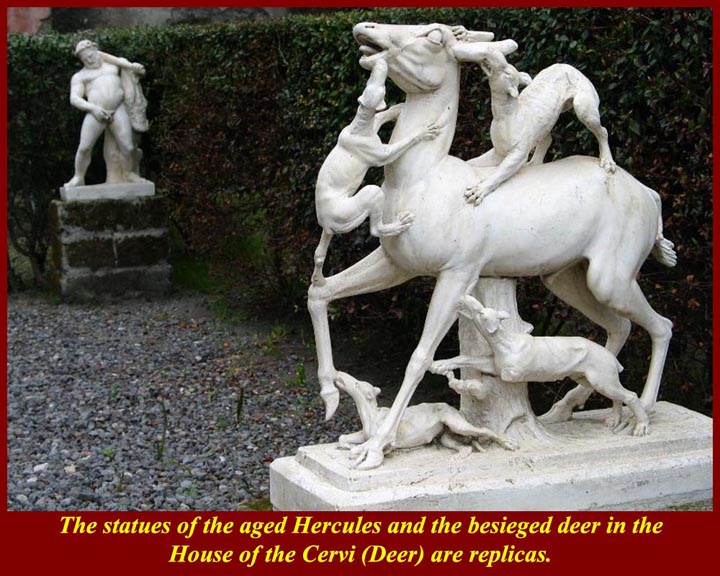
http://www.mmdtkw.org/ALRIVes0430CasaDeiCerviSculpture.jpg
The eponymous deer being attacked by a hunting pack.
Neither the foreground nor the background statue are originals
-- they are both in museums. The background statue is
Hercules with his club and lion skin thrown over his
shoulder. He's gotten old and fat -- I can
sympathize. And he's relieving himself in public -- I
haven't gotten there yet.
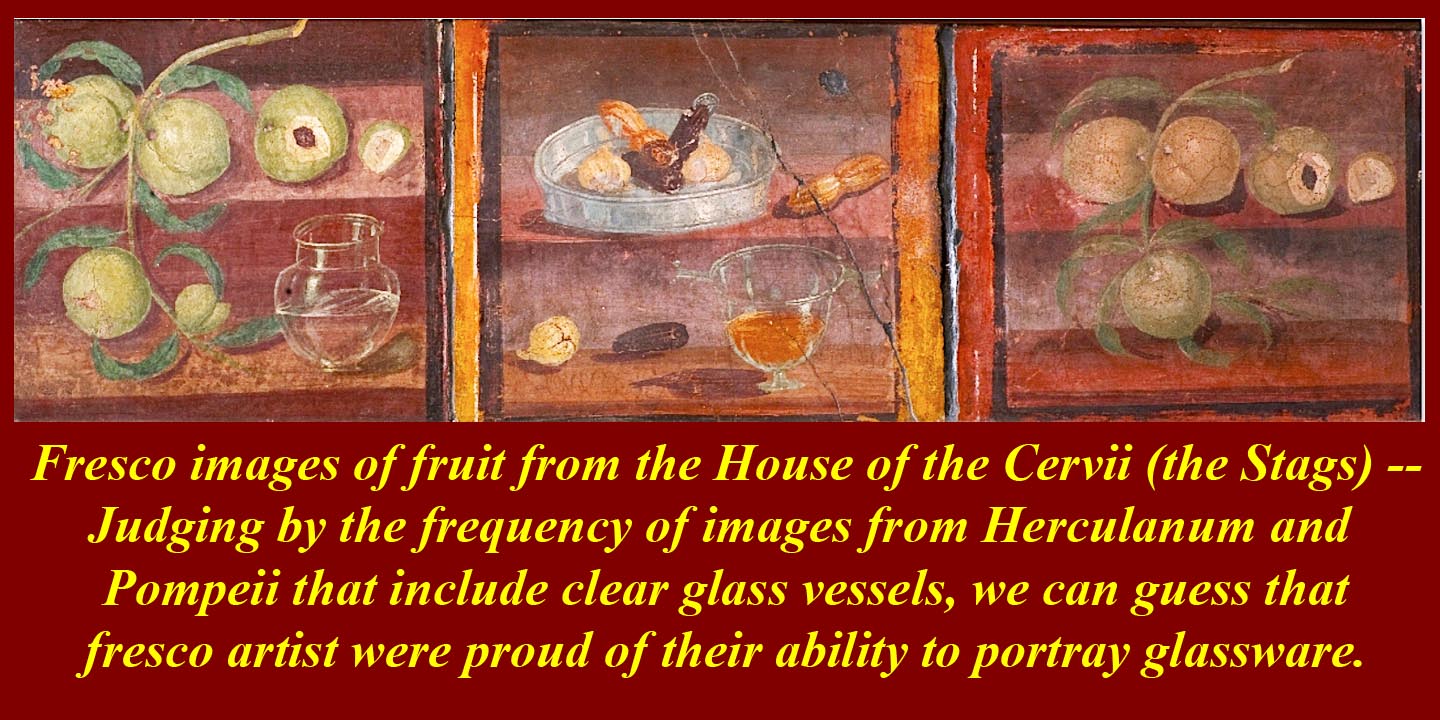
http://www.mmdtkw.org/ALRIVes0430xCerviHouseFruit.jpg
Fresco artist's show-off piece? Several images in
Herculanum, Pompeii, and opulent nearby villas feature clear
glass vessels containg either liquids, fruit, etc. -- mot easy
to portray in any media, but very hard to do in fresco.
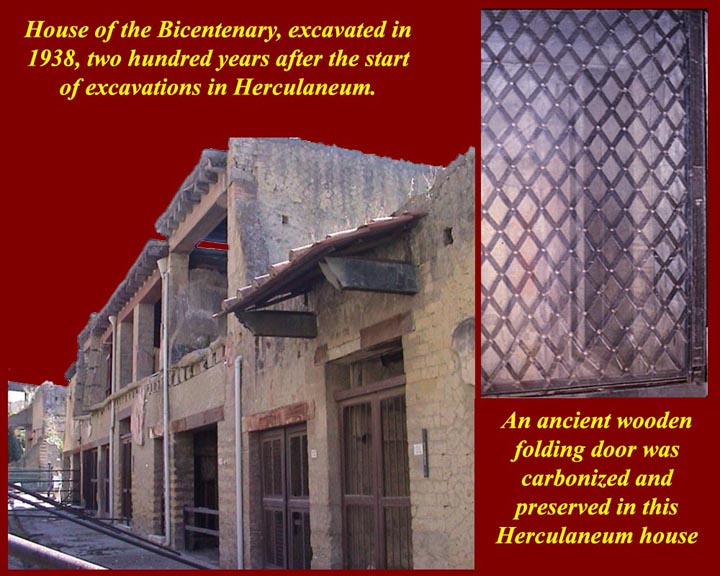
http://www.mmdtkw.org/ALRIVes0431BicentenaryHouse.jpg
The Bicentenary house is so-called because excavation reached a
"naming point" on the 200th anniversary of the start of
excavation in Herculaneum -- an arbitrary date in 1738 that the
archeologists and ideologues wanted to publicize in 1938.
Its most remarkable find was a still workable folding grillwork
partition. The carbonized original was too fragile to be
left on the site, so what you see now is a black painted
replica.
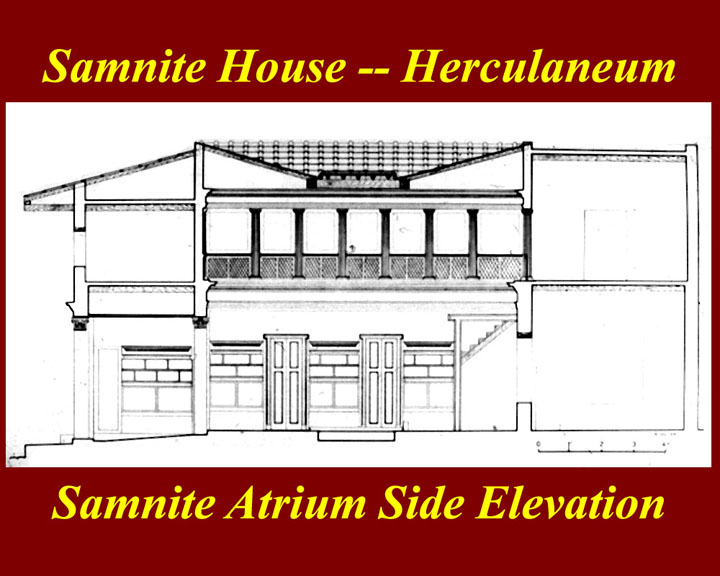
http://www.mmdtkw.org/ALRIVes0432SamniteHouseDiag.jpg
Considered to be the oldest "big" (i.e., rich) house in the
town, the Samnite House certainly dates from the pre-Roman
Oscan/Samnite period of the Campania (the Samnites were part of
the Oscan language group, or the other way around, depending on
which linguist tells you the story.) It has a two-storey
atrium that is very ornate. Atrium houses, which became
the standard for big Roman houses in cities (the Roman "Domus")
appear to have originate with the Samnites: at least the
earliest known examples are Samnitic and existed well before the
Romans were rich enough to build such big buildings.
Interestingly, when the Romans did start to build and decorate
this way, moralists objected that it was wasteful and
inconsistent with Roman "virtu". The Cato's -- Elder and
Younger -- railed against extravagance as did Cicero in several
speeches about too conspicuous consumption. We are (I
think) still waiting for the first Roman atrium house in
Arlington. I'd do it if I had the money.
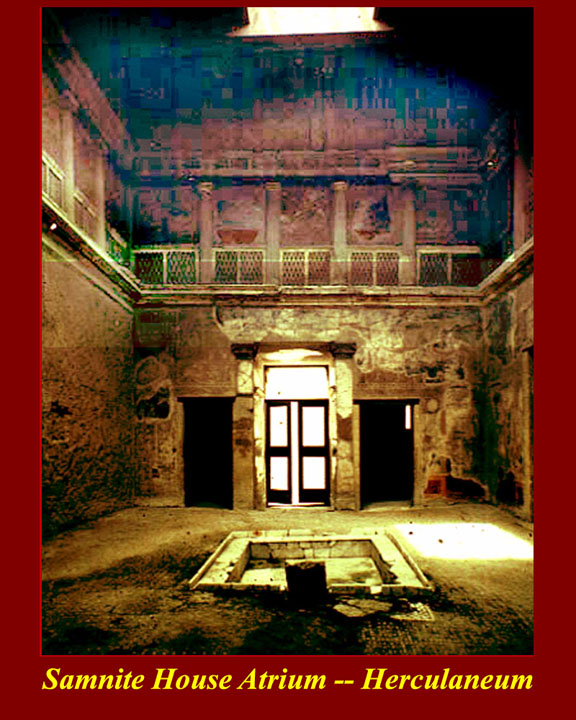
http://www.mmdtkw.org/ALRIVes0433SamniteHouseAtrium.jpg
The Samnite atrium that gave the house its name, looking toward
the front door.
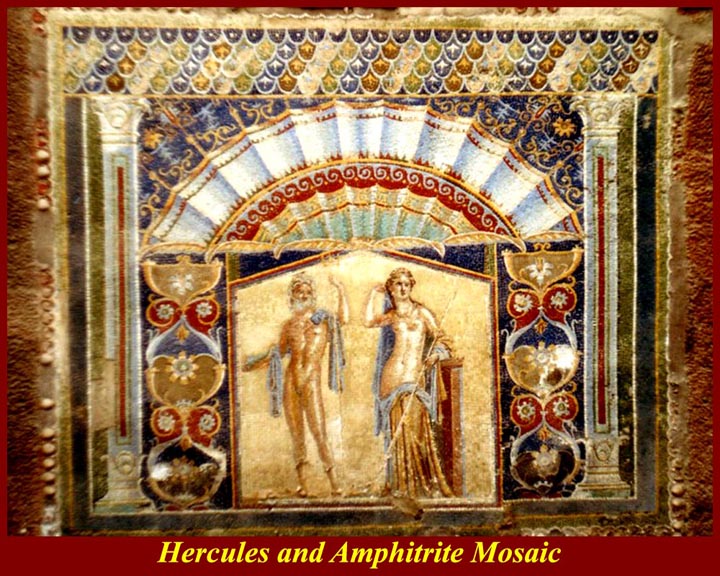
http://www.mmdtkw.org/ALRIVes0434NeptuneAmphitre.jpg
The Neptune-Amphitrite house got its name from this
mosaic. Modern scholarship classifies Pompeian and
Herculanese houses by their size and by their artwork. Big
and more fully decorated houses are, of course, deemed the
richest and trendiest. The last big trend before the
eruption that buried the area was the addition of big
mythological subjects, and mosaics were infinitely more "in"
than frescoes. This mosaic marked the house's owner as a
social lion -- maybe even the head of the pride. It is
part of a larger outdoor triclinium ensemble pictured below.
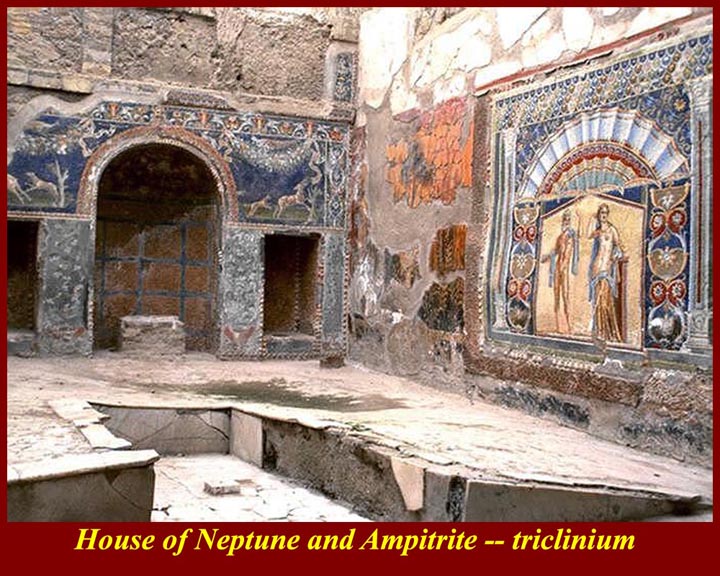
http://www.mmdtkw.org/ALRIVes0435NeptunHouseTriclin.jpg
The same mosaic seen in its place. The arched feature
with the two rectangular side niches was a nymphaeum -- a tres chic "water
feature". Both the mythological mosaic and the mosaic nymphaeum decorated an
outdoor triclinium or
dining area where people reclined on slanted (padded) lounges to
eat. The usually reclined three-to-a-couch, hence the
"tri" in triclinium.
Whoever
ate here clearly had the towns highest-class host.
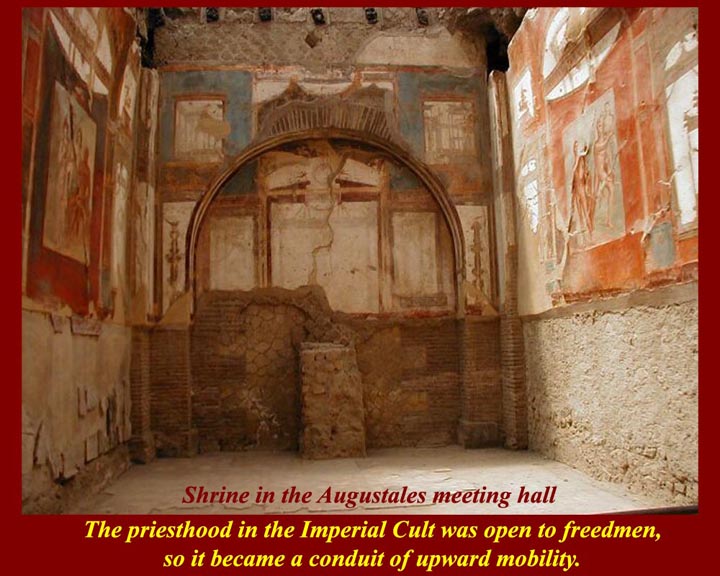
http://www.mmdtkw.org/ALRIVes0436AugustalesShrine.jpg
One month before the eruption of 79 AD Titus visited Herculaneum
and Pompeii to renew the Imperial cult in the name of his
recently deceased father, Vespasian. He would have visited
this building, which was the headquarters and meeting place of
the Augustales -- Priests of the Augustan cult. This was
not the temple of the cult, but it, naturally, had an Augustan
shrine. A new statue of Vespasian would have been on the
pedestal and new coins dedicated to the deified deceased emperor
would have been distributed.
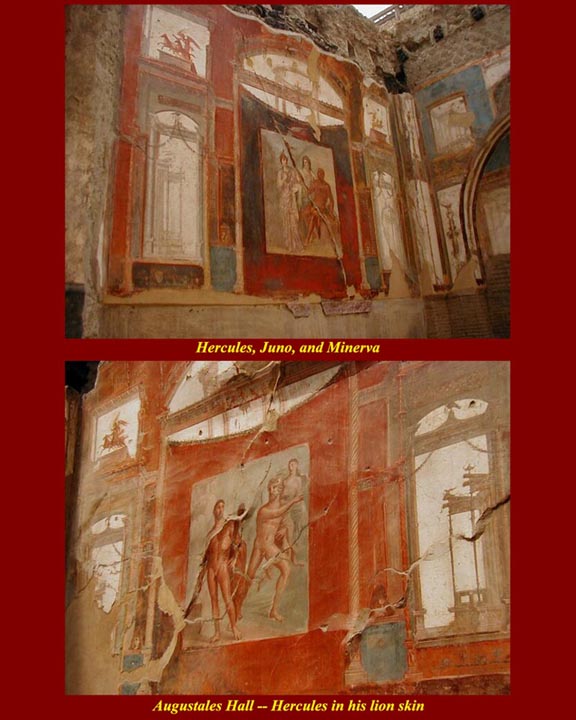
http://www.mmdtkw.org/ALRIVes0437AugustalesHercules.jpg
This was, after all, Herculaneum, a town dedicated to and
supposedly founded by Hercules, a demi-god and hero. The
two sides of the Augustan shrine in the Hall of the Augustales
were decorated with Hercules, Juno, and Minerva on one side and
Hercules with his club and lion skin on the other. It also
has a fine opus sectile
marble floor.
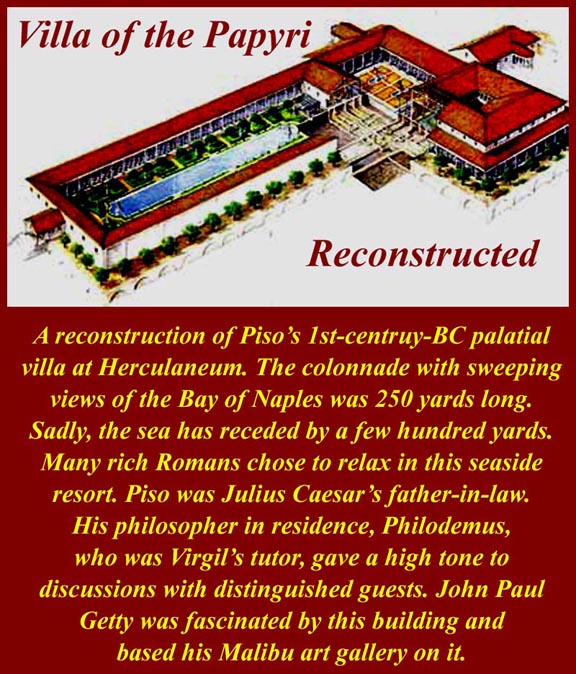
http://www.mmdtkw.org/ALRIVes0438VillaPapyriReconst.jpg
The most sumptuous villa on the
fringe of town -- at least so far discovered -- is called the
Villa dei Papiri or the Villa of the Papyri. It is thought
to have belonged the
Calpurnii, the family of
the father-in-law of Julius Caesar. Lucius Calpurnius Piso
was the father of Calpurnia, she who was spurned when he took up
with Cleopatra. That's another long story for a different
time and place. At any rate, the alternate name of the
house is Villa Pisonis (or Pisonensis). Piso was well
known to have indulged and endowed a previously itinerant Stoic
philosopher named Philodemus and was reputed to have the best
private library in the Campania if not in the Roman world.
When, in 1778, workers came upon thousands of carbonized
scrolls, many of which when finally unrolled turned out to be
Philodemian commentaries on stoicism, it was easy to identify
the Villa as Piso's -- it helped that written sources had said
he had plush digs in the area.
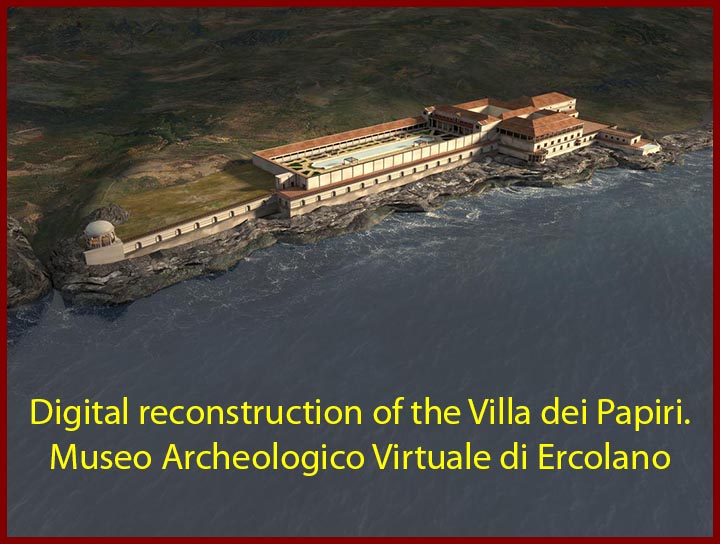
http://www.mmdtkw.org/ALRIVes0438wVillaDeiPapiri.jpg
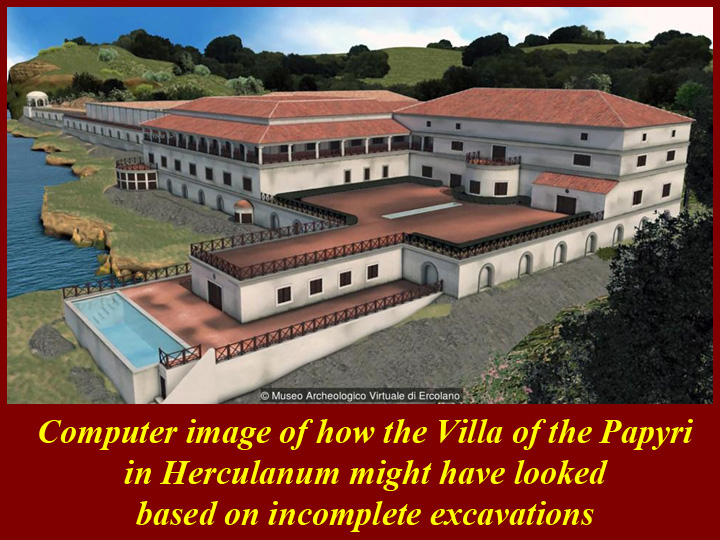
http://www.mmdtkw.org/ALRIVes0438xComputerVillaPapyri.jpg
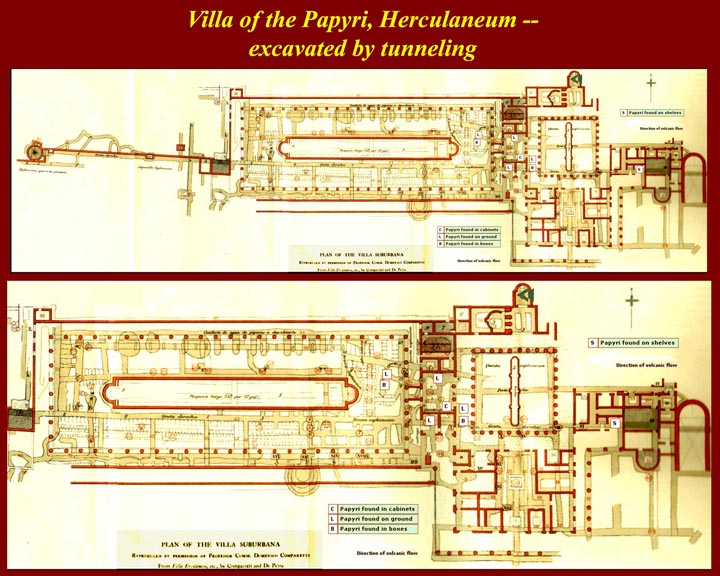
http://www.mmdtkw.org/ALRIVes0439PapyriVillaPlanSlide.jpg
Tunneling in, around and through the Vill was extensive (but not
complete -- see below.) The building itself was most
impressive and there were all those scrolls and then hundreds of
bronze and marble sculptures -- more evidence that it was Piso's
villa as he was an avid and very wealthy collector. The
image show an overall plan and a magnification of the main Villa
(i.e., without the belvedere on the next rise.) Look
closely and you can see the outlines of the tunnels. There
was certainly enough tunneling to get a very good architectural
outline of the structures and to elucidate the decorations which
graced it. Only in the last few years has partial real
excavation begun.
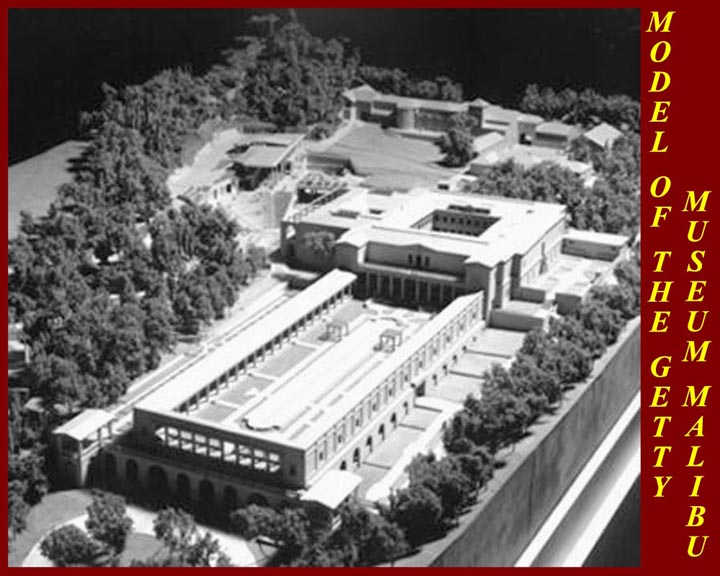
http://www.mmdtkw.org/ALRIVes0440GettyModel.jpg
In the 20th century, another rich collector, oil billionaire J.
Paul Getty decided that the Villa of the Papyri just had to be
duplicated. He built it as a residence in 1971 but died
before he could move in, leaving behind a cool $2 billion as an
endowment, making it the richest museum in the world. It
was closed for several years -- first for renovations and then
by a NIMBY lawsuit brought by neighbors. The Getty Trust
won the lawsuit and the museum (actually half -- the other
campus is in Los Angeles) re-opened in February of 2006.
The picture is of a model, which does not show new additions. Below are some images of the
Getty gallery in Malibu, which as closely as possible was built
and decorated to be an exact copy of the Villa of the
Papyri. Ih as recently been reopened in 2006 as a research
center and museum after being closed for a number of
years. The Getty collections include more than 44,000
Greek, Etruscan, and Roman artifacts, which are displayed on a
rotating basis. For More information, see https://www.getty.edu/visit/villa/
and https://en.wikipedia.org/wiki/Getty_Villa.
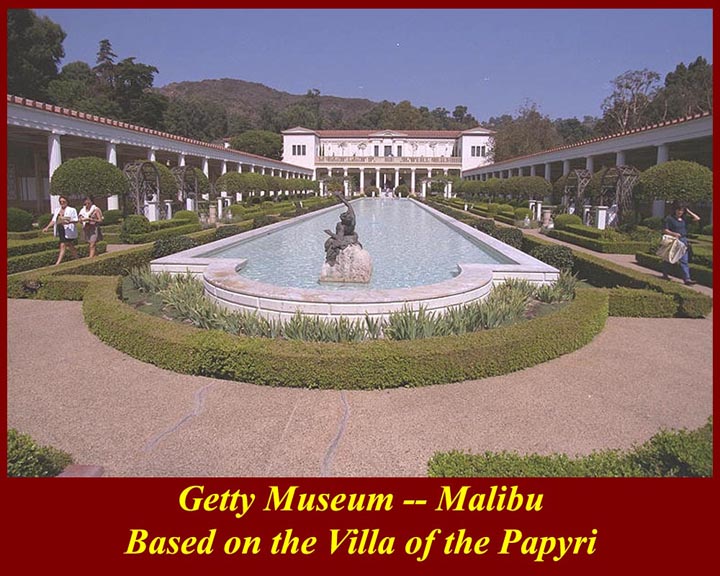
http://www.mmdtkw.org/ALRIVes0442GettyMalibu.jpg
The large pool: a smaller one is in an inside courtyard. Bronze
statues were cast from the originals and marble sculpture are
point-for-point copies of the Roman marbles (which, of course,
were point for point copies of Greek bronzes). They are
all over the villa in great profusion.
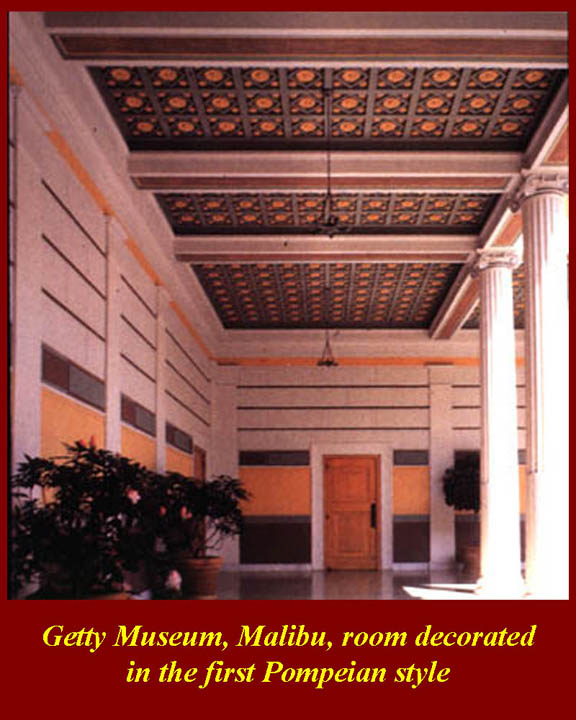
http://www.mmdtkw.org/ALRIVes0443GettyFirstStyle.jpg
One of the porticoes of Getty Malibu in the "First Style" of
Pompeii -- stucco panels simulating marble. There were three
succeeding styles -- or better said, additional styles.
They were all eventually used simultaneously in different rooms
of the same big houses and the first three had diffused to lower
societal levels by the time of the 79 AD eruption.
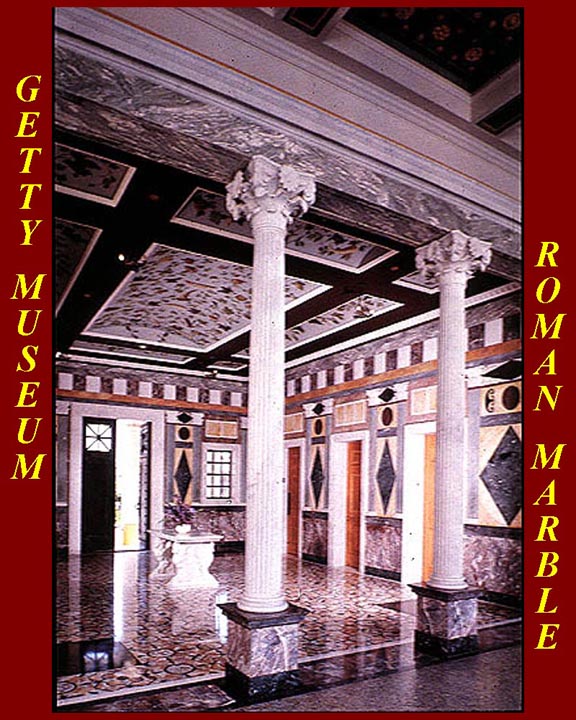
http://www.mmdtkw.org/ALRIVes0444GettyMarble.jpg
Real marble used as it was in the Villa of the Papyri.
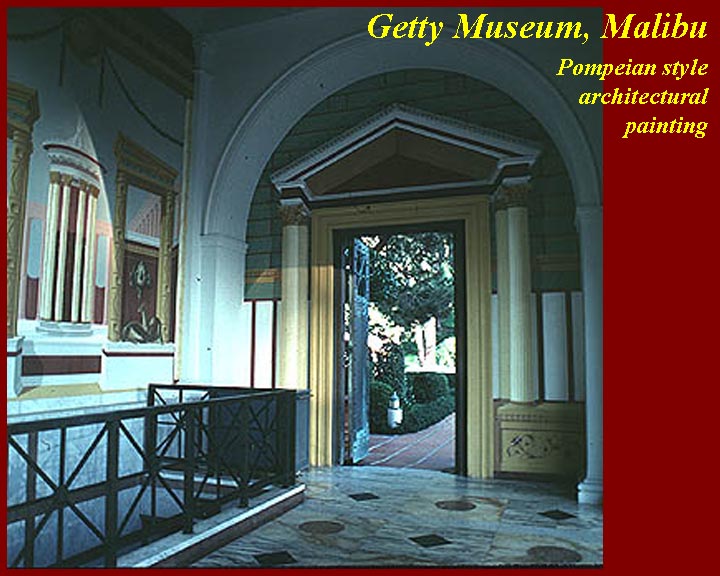
http://www.mmdtkw.org/ALRIVes0445GettyTholosWall.jpg
The "Room of the Tholos Wall" is a copy of a Third Style room in
the Villa of the Papyri. The tholos is the round structure
on the wall to the left. All the architectural
decorations, including those around the doorway, are painted on
the walls: That's what Third Style mainly was.
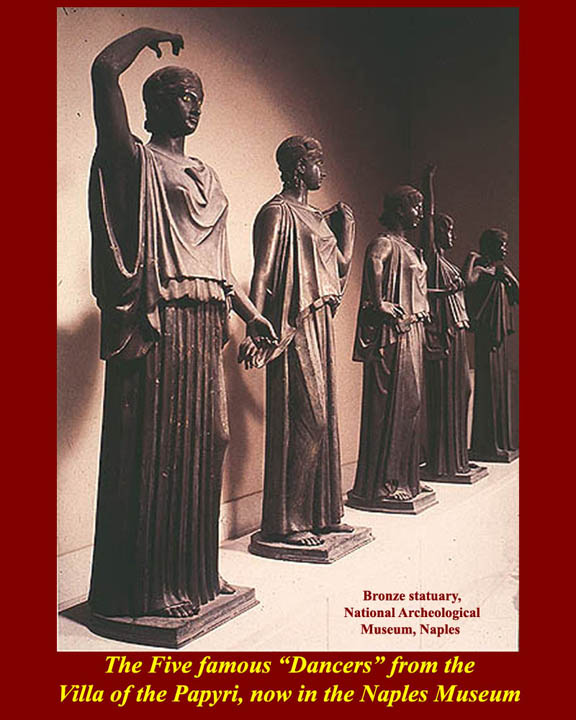
http://www.mmdtkw.org/ALRIVes0446papiri5dancers.jpg
The "Five Dancing Women" statues from the Villa of the Papyri
are posing, not dancing, although the first one on the left does
seem to be holding a figure from a anachronistic Neapolitan
Tarantella. They are now in the National Archeological
Museum in Naples and copies are in both the Herculaneum site
museum and in the Malibu Getty. Recent studies of the
statuary indicates that these most famous of the Villa dei
Papiri sculptures are cheaply made and even composed from stock
molds. ("Composed" sets of bronzes use molds to repeat the
same hands, arms, clothing pieces, faces, etc., for "lost wax"
from which the mold for each sculpture is made.
Features on these statues show too much in common not to be
composed.)
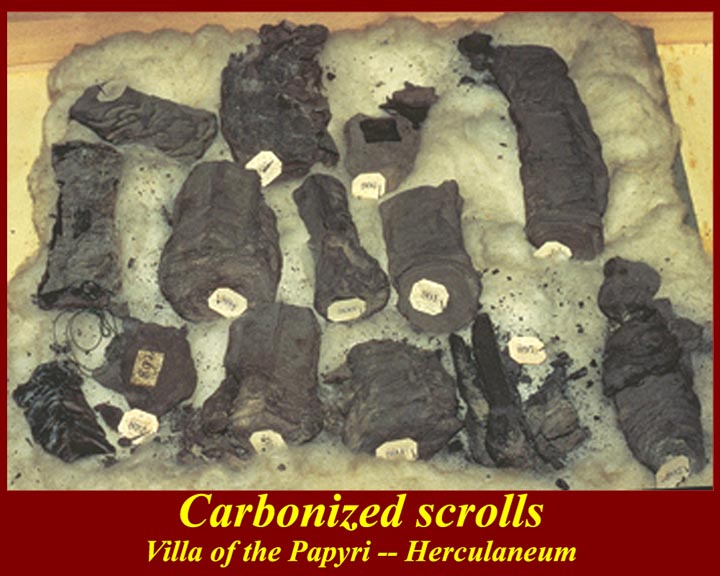
http://www.mmdtkw.org/ALRIVes0441Papyri.jpg
Some of the scrolls that gave the Villa its name.
http://www.mmdtkw.org/ALRIVes0447MultiSpectralPhotog.jpg
The Papyri are extremely fragile and once unrolled -- an arduous
process using complicated machines based on a very old model
(see handouts) they are extremely difficult to read.
Think black on black or brown on brown. Most inks of the
day were based on black carbon and these scrolls are carbonized.
The fluid that carried the carbon-black was usually
slightly acid, so there are traces of acid damage that can be
worked with, as long as the acid did not eat all the way through
and into the next layer. New processes based on NASA
imaging of planetary and other surfaces has helped. The
main NASA process is called multi-spectral photography. In
its simplest and oldest form, light of different colors was
filtered out and only certain wavelengths reached the
films. When recombined and manipulated, details of
surfaces, planetary or documentary, could be brought up.
Newer imaging methods involving electronic light filters and
detectors have made it possible to work with many more
frequencies, and
computers have made manipulation of the images easier.
Some of this can be done with off-the-shelf computer programs
and even more with proprietary programs. Brigham Young
University is a big player in the effort to read the Papyri from
the Villa dei Papiri (see https://magazine.byu.edu/article/a-library-of-mud-and-ashes/)
as is UCLA which is involved in the Philodemus Project (see https://classics.ucla.edu/faculty-projects/philodemus-project/).
Attempts
to use computerized tomography to read scrolls that are still
rolled are still in the experimental stage.
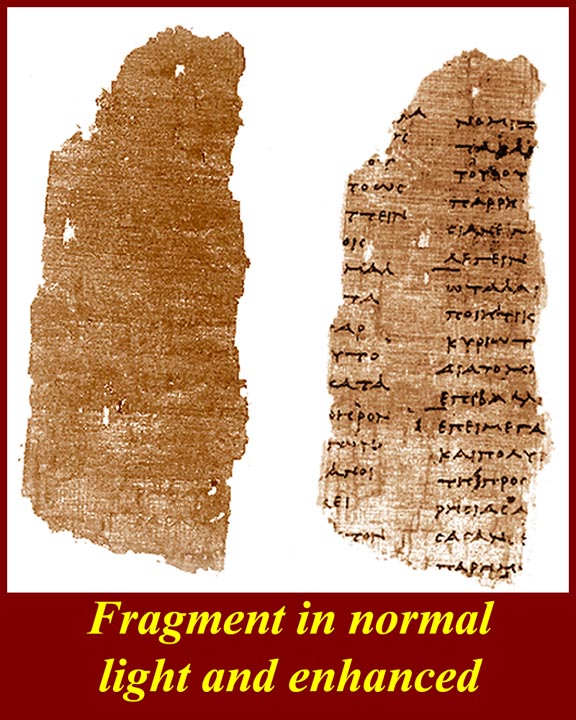
http://www.mmdtkw.org/ALRIVes0448ColorizedFragment.jpg
What multi-spectral photography
can do. Much more is available at the two web sites given
with the previous image.
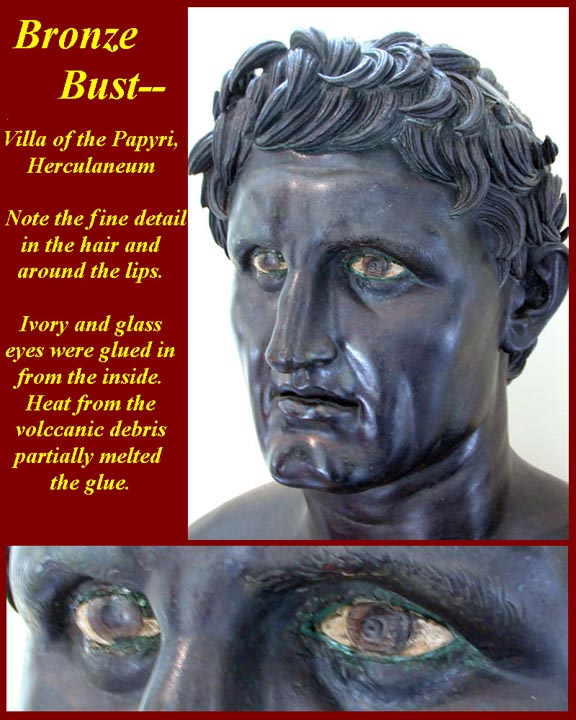
http://www.mmdtkw.org/ALRIVes0449SeleucoINicatore.jpg
The Villa of the Papyri was also the source of the largest
trove of ancient bronze statuary -- scores of life-size and
larger full-scale statues, busts, and herms. There were at
least four bronze foundries around the Bay of Naples in ancient
times, and some patterns were reproduced extensively. It
appears that, in addition to making replicas, they also turned
out fakes of "original" Greek bronze work, replete wit missing
limbs, age marks, and other "flaws" designed to fool
unsuspecting buyers. Even such sophisticates as Piso, the
probable owner of the Villa of the Papyri, (or his heirs) could be fooled. At least one
of his bronze busts, the "Archaeistic Apollo", was a fake.
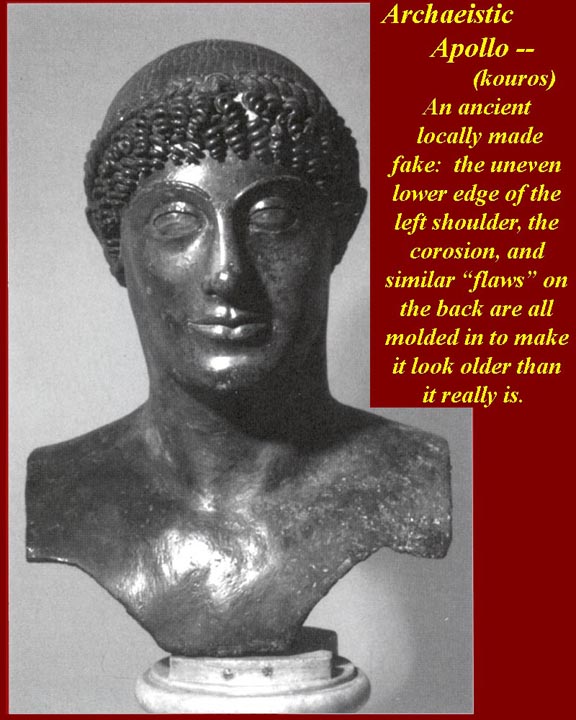
http://www.mmdtkw.org/ALRIVes0450aArcheisticApolloFake.jpg
The ancient fake "Archaeistic Apollo" (or perhaps just a kouros
-- a young man) was acquired by Piso or his heirs. The
"wear and tear" at the bottom of the left shoulder -- the uneven
edge and "corrosion" -- and similar flaws and drip marks on the
back were all molded in at the time of its
manufacture. It is called "archaeistic" because it
was manufactured to look like a truly old, i.e., "archaic",
piece of sculpture.
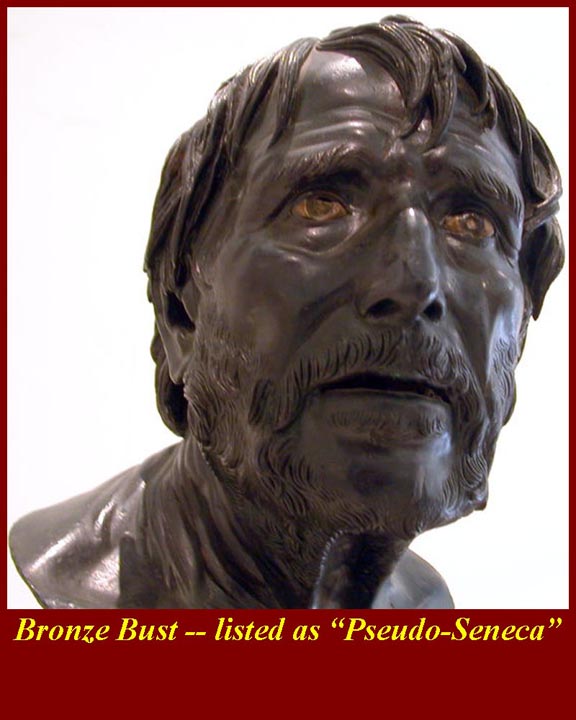
http://www.mmdtkw.org/ALRIVes0450Seneca.jpg
The "pseudo-Seneca" bust was once thought to be Seneca, who had
been Nero's tutor. When it was first mounted in the Naples
Archeological Museum it was leaned forward as seen in the
picture. Some modern "authorities" say it should show a man
with his head thrown back, perhaps in laughter.
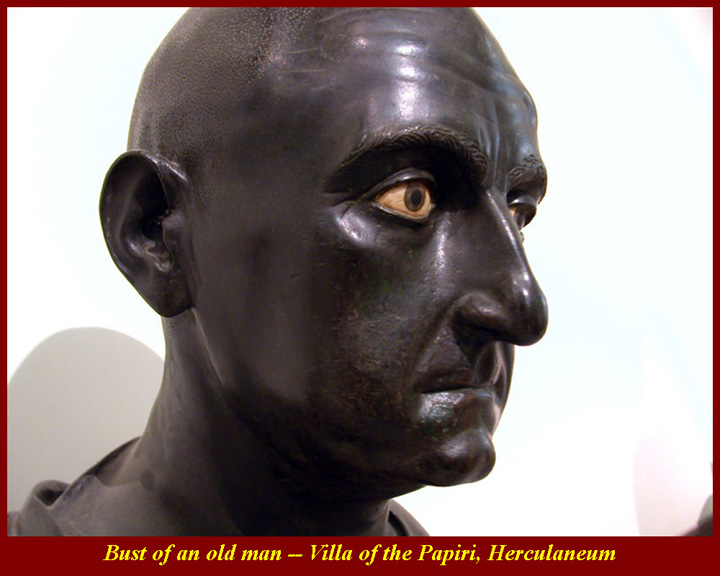
http://www.mmdtkw.org/ALRIVes0451Old_man.JPG
An unidentified old man with shaven head.
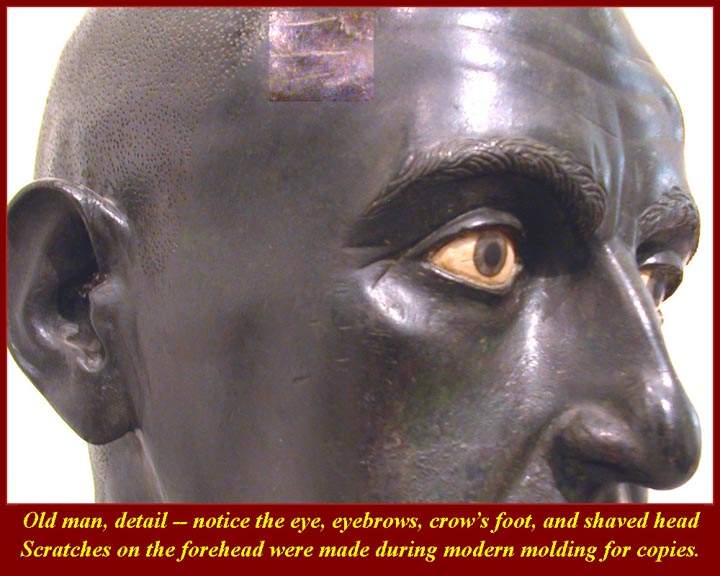
http://www.mmdtkw.org/ALRIVes0452Old_man.jpg
A closer view of the same bust, to show details -- the eye is
ivory with a glass pupil. Note also the individual hairs of the
eyebrows, which would have been carved by hand into the wax
original, the crows-foot at the corner of the eye, and the
individual hair follicles picked out on the scalp. The
highlighted scratches on the forehead are later additions --
part of the process of making molds in the 18th or 19th century
for making bronze and plaster copies.
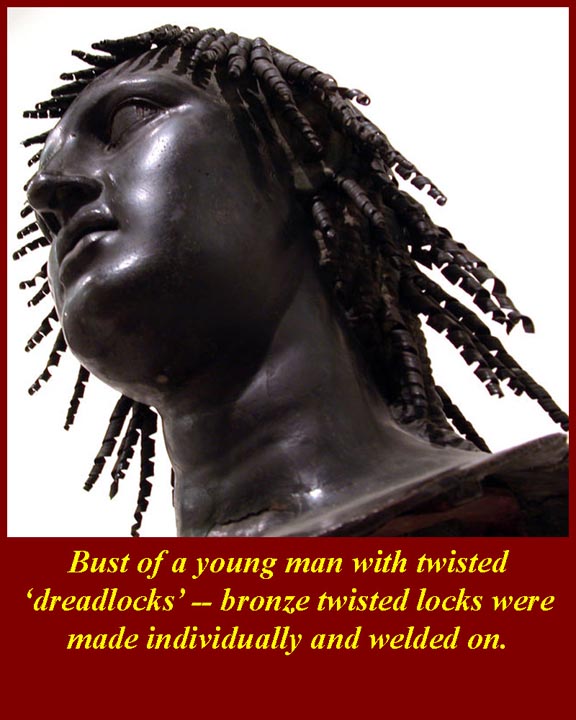
http://www.mmdtkw.org/ALRIVes0453Young_man.jpg
Dreadlock man -- Bronze bust of a young man with twisted
hair. The locks were made separately and welded to the
head.
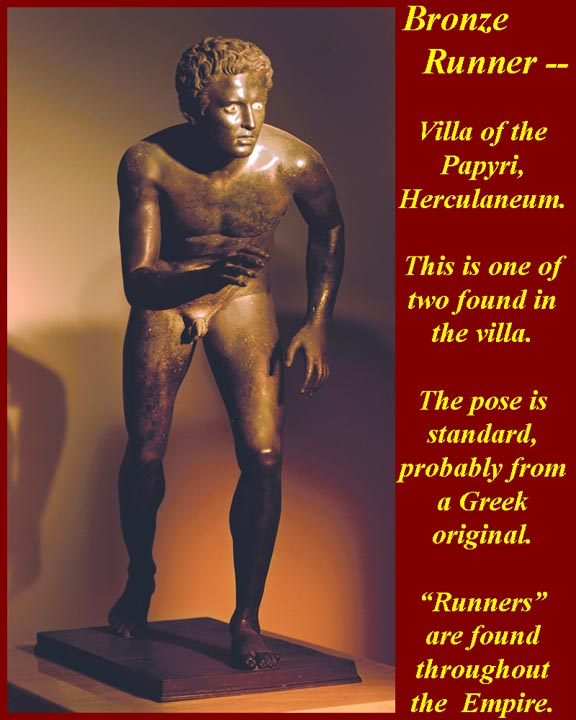
http://www.mmdtkw.org/ALRIVes0454BronzeRunner.jpg
One of two larger-than-life bronze runners found in the
villa. The image was popular all over the Empire.
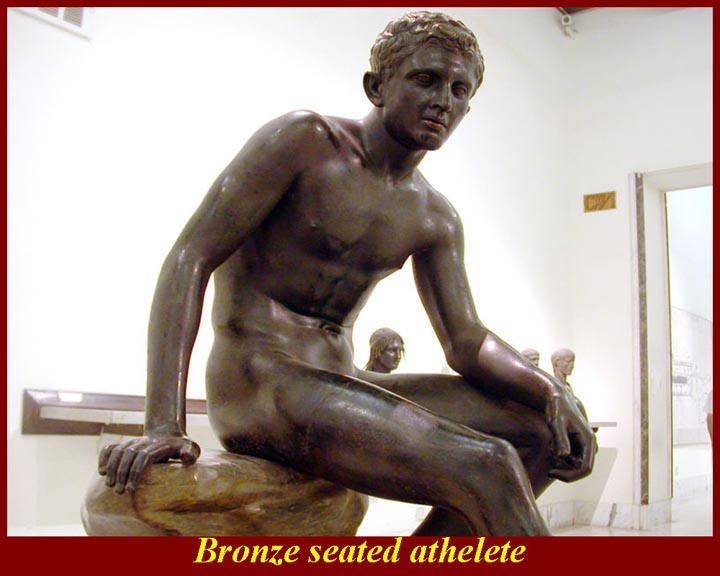
http://www.mmdtkw.org/ALRIVes0455Athlete.jpg
Bronze seated or resting athlete
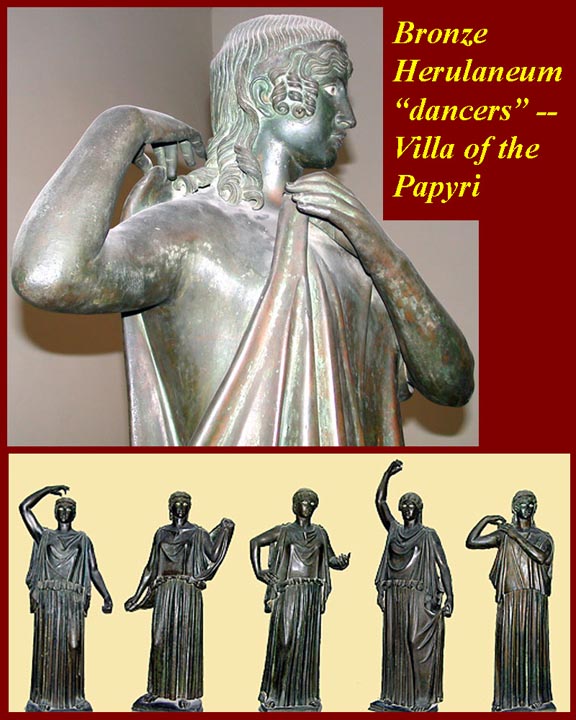
http://www.mmdtkw.org/ALRIVes0456Danzatrice.jpg
The "dancers" are not really dancing: this one is
fastening her garment at the shoulder. The bronze work of
is not up to Piso's normal standard -- maybe purchased by a less
cultured descendant?
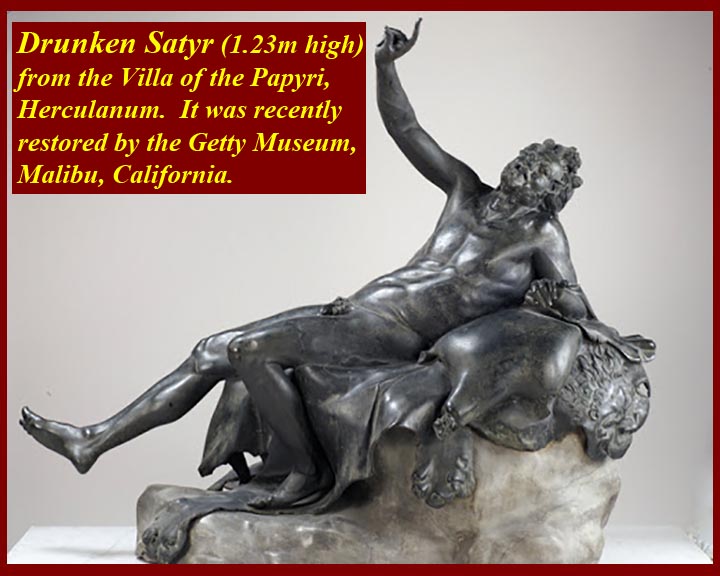

http://www.mmdtkw.org/ALRIVes0459DrunkenSatyrPapyri.jpg
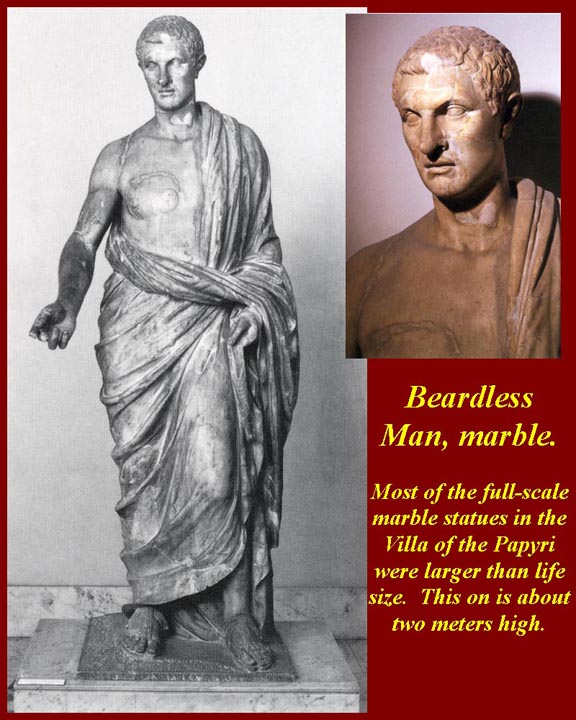
http://www.mmdtkw.org/ALRIVes0457BeardlessManMarble.jpg
Piso also collected marble sculptures -- at least 80 have
been excavated. This one is sometimes identified as Piso,
but for no particular reason.
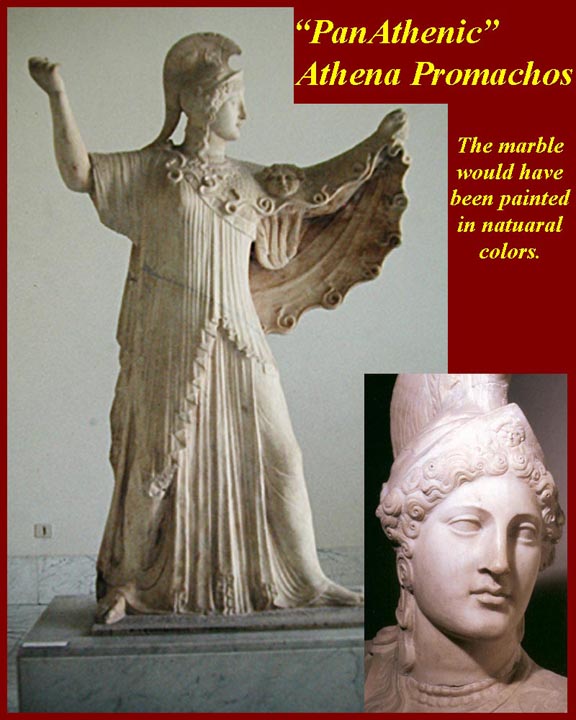
http://www.mmdtkw.org/ALRIVes0458PanathenicAthena.jpg
Athena spreads her protective mantel (her aegis).
This is sometimes incorrectly identified as a copy of the Athena
Promachos, a colossal (30 foot tall) bronze statue sculpted by
Pheidias in 450 BC -- no proven copy is known to exist. It
is, however, a generic Athena Promachos (Athena "a front-line
fighter") in a characteristic pose with a thrusting spear
(missing) and her left arm and her mantel extended
protectively. Written sources and coin images of the
Pheidian colossus sometimes show her without the mantel and with
a shield resting against he right leg. Athena Promachos
images were very common and varied considerably. The
imagery of Athena Promachos certainly predated Pheidias, and
even then it was current in various forms. The statue by
Pheidias was transported to Constantinople in the late 5th
century AD and was destroyed there in 1203 by
a superstitious mob, who believed that Athena was beckoning the
Crusaders to enter the city. The destruction of the
colossus did not deter the Crusaders, who sacked the city anyway
the next year.
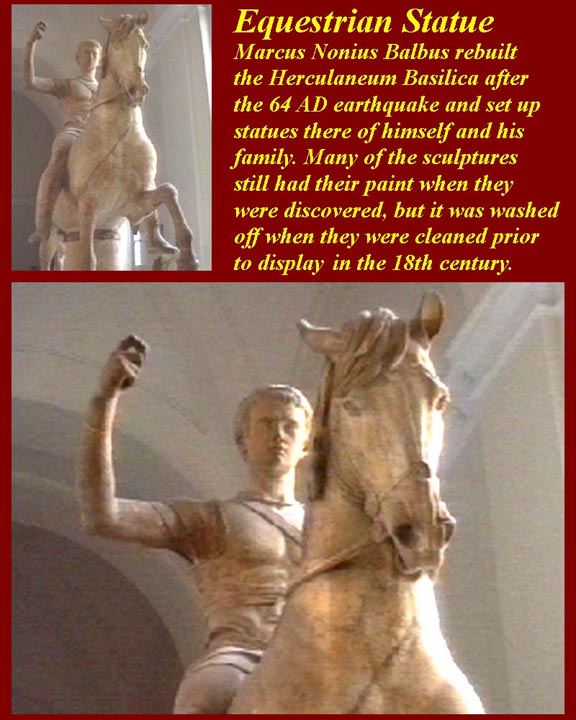
http://www.mmdtkw.org/ALRIVes0459BalbusBasilicaEquestrian.jpg
The basilica in the Herculaneum forum was leveled by the
earthquake of 62 AD, and was rapidly reconstructed by a local
politician (a Proconsul), Marcus Nonius Balbus. Balbus
then decorated the Basilica with marble portrait statues of his
family and of the labors of Hercules. He erected
equestrian statues of himself and his son out front. The
image is of Balbus Minor (the son) and is now in the Naples
archeological museum. Statues such as this would have been
painted in naturalistic colors. Paint was, in fact,
recorded on many of the statues from the basilica when they were
discovered in the late 18th century -- Alcubierre's tunnels had
reached the Basilica in 1739, but it took many years to extract
the statuary and some remarkable frescoes. Unfortunately,
the paint was washed off during the cleaning process prior to
their display of the sculptures in the National Archeological
Museum in Naples. Only recently was a head of a
statue recovered which still had visible paint. The story
of the Amazon's head (identifiable by its swept back hairstyle)
hit the world media at the end of March 2006.
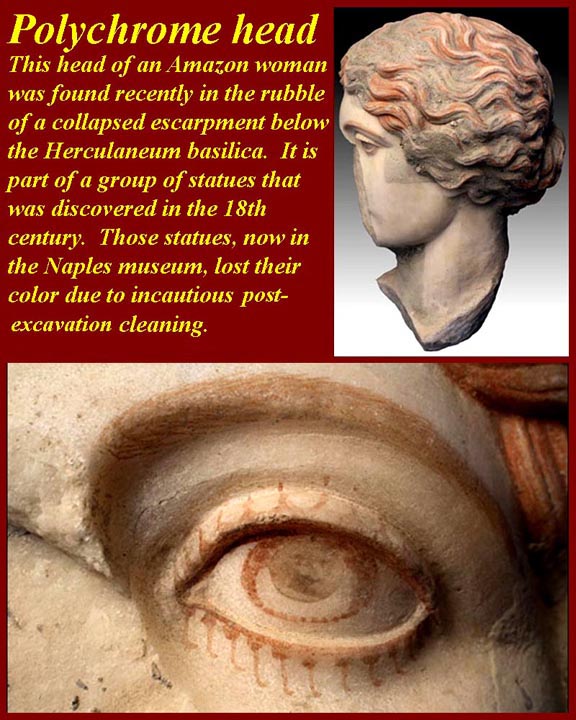
http://www.mmdtkw.org/ALRIVes0460PaintedStatue.jpg
A ecently found polychrome Amazon's head. It was separated
from the rest of the statue during the 79 AD eruption and found
in the talus at the base of a collapsed escarpment.
The Amazon may have been associated with the story the ninth of
the twelve "Labors" of Hercules, in which he has to retrieve the
belt of Hippolyte, the Amazon queen.
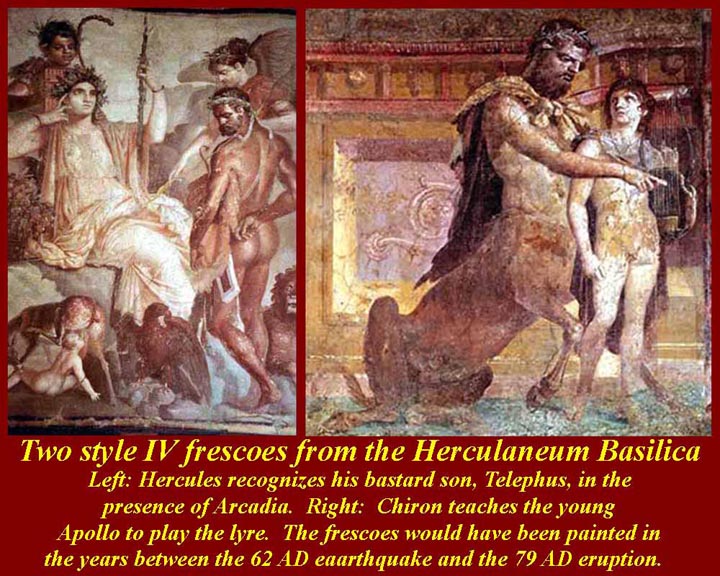
http://www.mmdtkw.org/ALRIVes0461BasilicaFrescoes.jpg
Several extraordinary frescoes were recovered from the
Herculaneum basilica and mounted in the Naples National
Archeological Museum. These two show (1) Hercules
recognizing Telephus, his bastard son, in the presence of
Arcadia (Telephus is the child being suckled by a roe deer in
the lower left of the fresco) and (2) Chiron, the wise centaur
and the only immortal
centaur, teaching the
youthful Apollo how to play the lyre. Chiron taught
several Greek gods and heroes including Apollo, Achilles,
Aesclepius, Acteon, and Hercules. Chiron, an
innocent bystander, was accidentally wounded in the knee by an
arrow shot by Hercules, during a fight with other Centaurs over
a jar of wine. Chiron's wound would not heal -- the arrow
had been dipped in the blood of the monster, Hydra -- and,
because of his immortality, he live on in terrible pain.
To gain relief, he eventually traded his immortality for
the release of his friend, Prometheus.



























































































